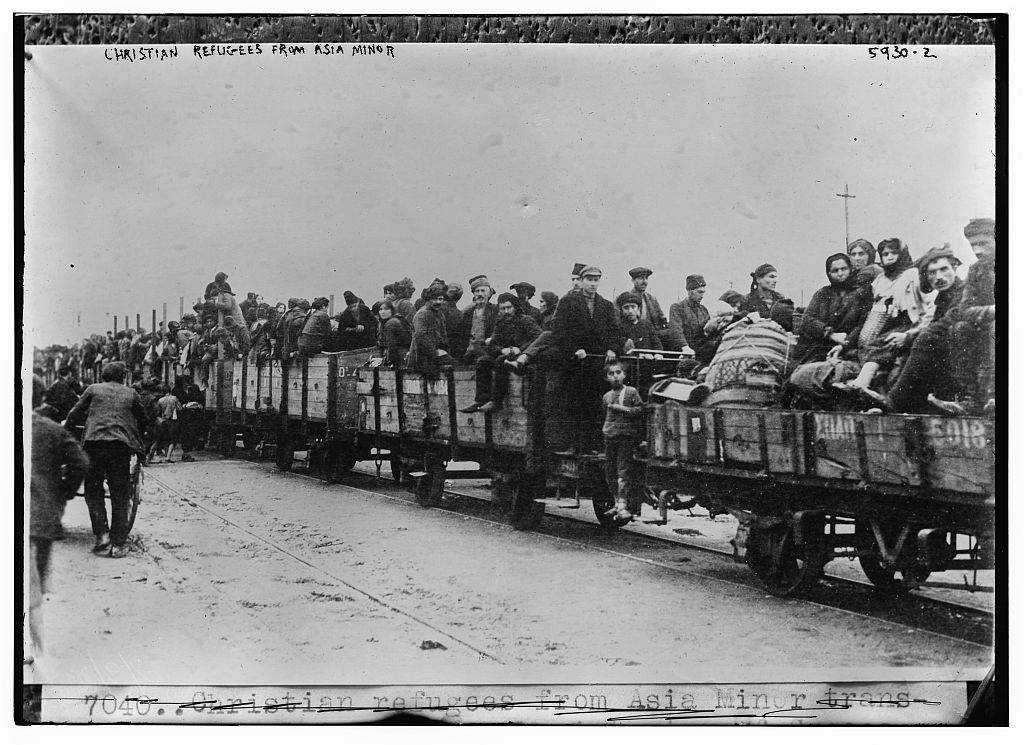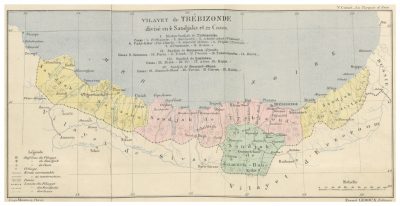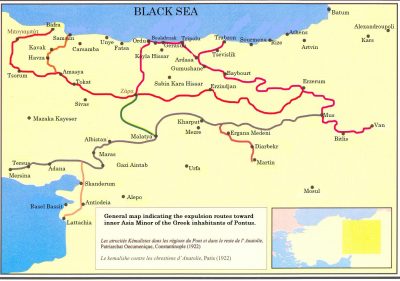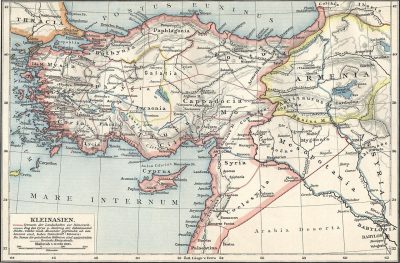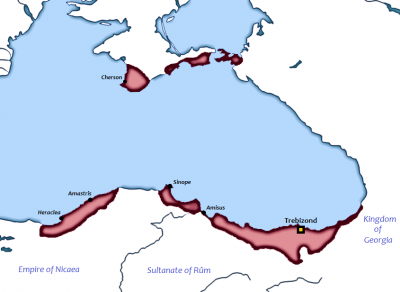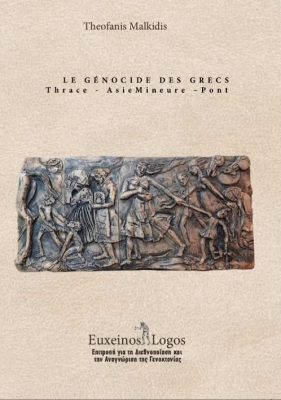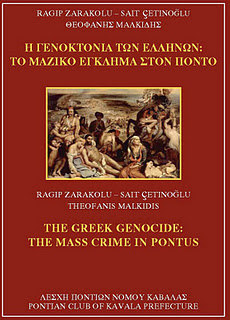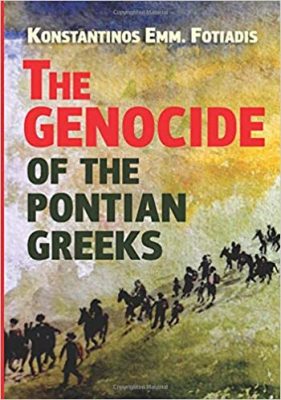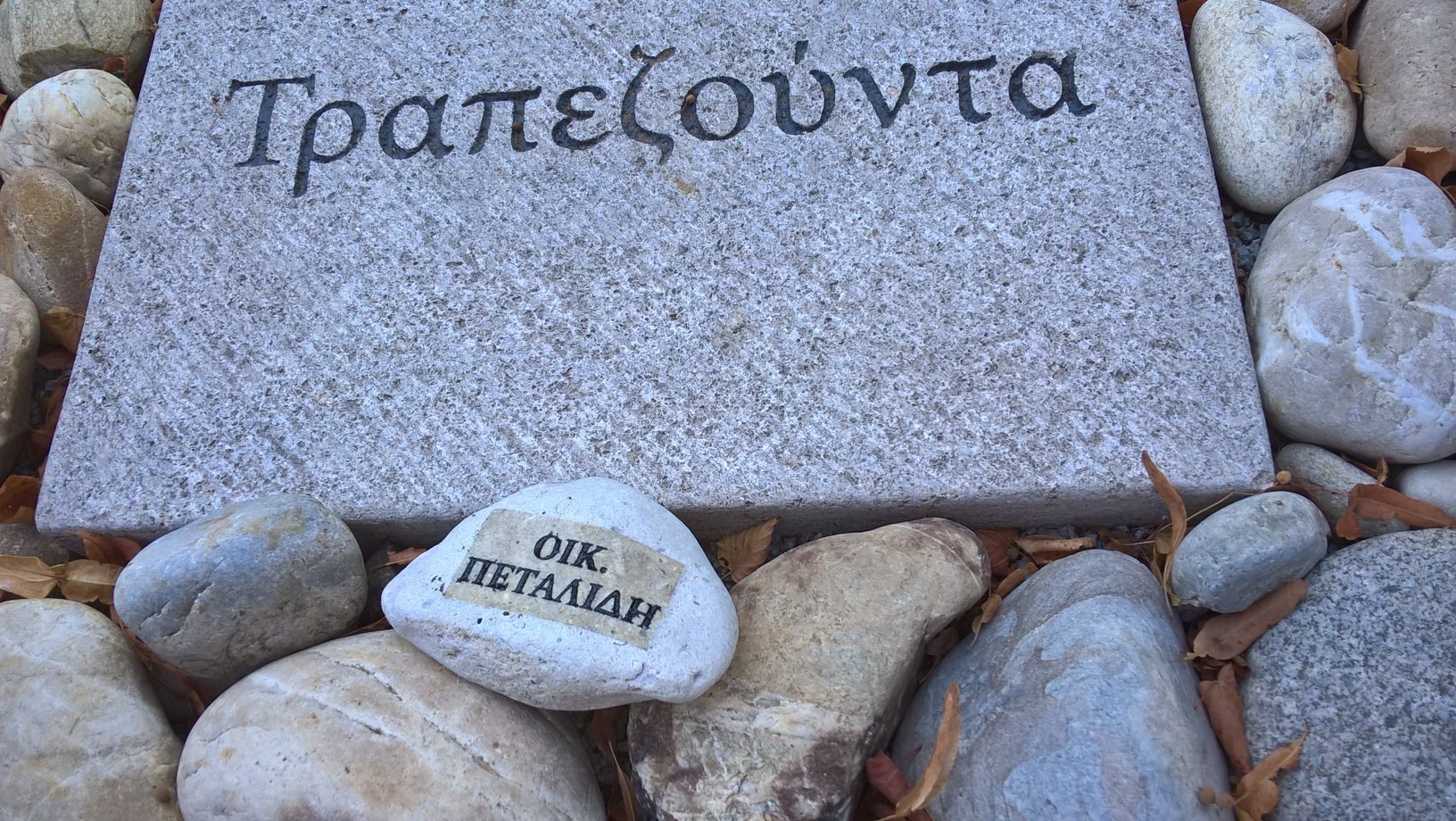
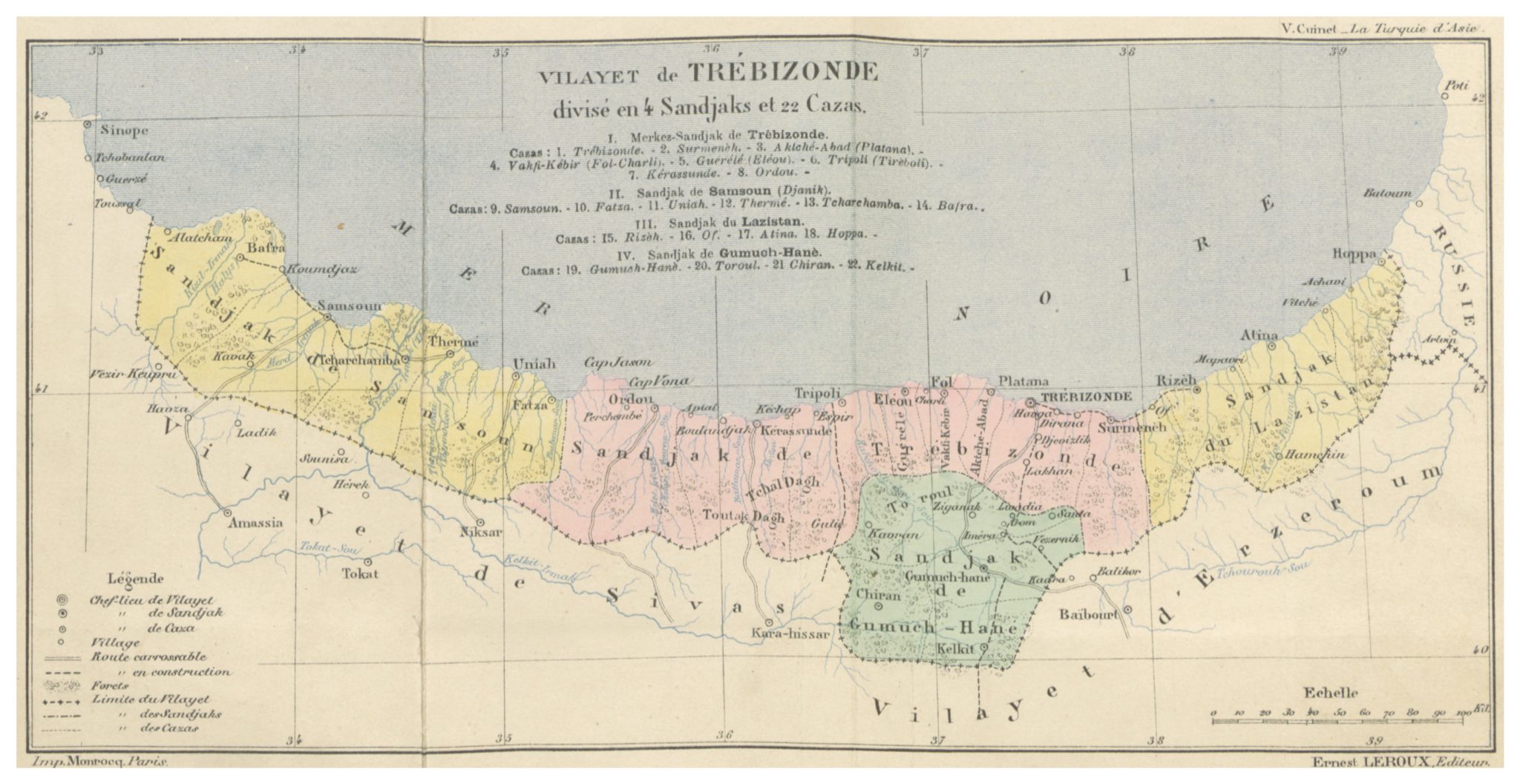
Administrative Division
Located on the southern Black Sea coast and named after its capital, the province was created in 1867 in the course of the Ottoman administrative reform as the successor to the former Eyalet Trabzon and initially comprised the three sancaks Trabzon, Gümüşhane (Grk.: Agyroupolis) and Lazistan (Rize); this sancak in the very east of the province was created after the Russian-Ottoman war of 1877/8. In 1889, the sancak Canik with the capital Samsun was added to the west, so that the province covered a total area of 31,300 square kilometers with four sancaks and 22 kazas. Thus, the province included not only the narrow coastal strip but also the mountainous hinterland of the Pontos Mountains.
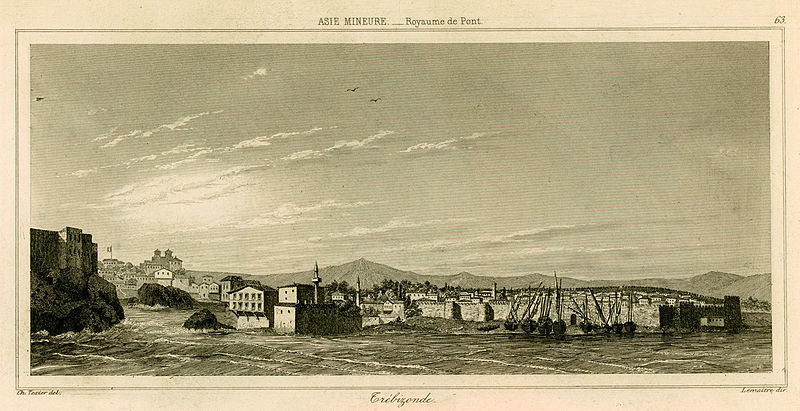
Population
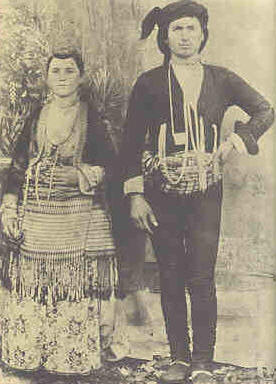
In the 19th century, the number of Christians in the province of Trebizond fell sharply. When, as a result of the Berlin Congress (1878), Russian forces withdrew from the Batumi, Kars and Ardahan areas, there was a mass exodus of over 100,000 Greeks and Armenians from the eastern Pontos area.
In 1900 the population was 1.2 million; the first Ottoman census of 1885 (published in 1908) showed a population of 1,047 million. At the 1914 census, 921,128 inhabitants were Muslim, 161,524 Greek Orthodox and only 38,899 Armenians (Armenian Apostolic).
Armenian Figures
In contrast, the Armenian Apostolic Patriarchate of Constantinople indicated the number of Armenians in the province on the eve of the First World War at 73,395 in 118 localities. At that time the Patriarchate owned 106 churches and 31 monasteries in the province of Trabzon, and maintained 90 schools for 9,254 pupils.(1)
Greek Figures
As to the low figures officially given for the Greek Orthodox population of the Trebizond Province, the jurist Aristotelis Neofytos of Kerasunt (Tr.: Giresun) commented: “According to the last official almanac or yearbook (Salname) of the year 1321 (1904), the governmental district of Trebizond has 1,254,816 inhabitants, of whom only 194,169 were described as Greeks, i.e. only 2/5 of the actual total number. This is due to the fact that the Turks are only interested in the Turkish population because of the military service, whereas the Greeks, who were not called up for military service before the last war, did not have the births entered in the civil registry books in order to avoid paying the military service substitute tax. (…) In my calculations based on the list of the Turkish Yearbook of Population Increase, I found that at the beginning of the war (1914), the Greek population of Trebizond county was certainly 485,000 souls, compared to (…) about 850,000 or 900,000 Muslims of all nationalities, including the Stavriots.”[2] A somewhat higher estimate by Dimosthenis Oikonomidis (Ikonomidis) assumes 530,000 Greek Orthodox in the province of Trebizond.[3]
According to the statistics by Panaretos, abbot of the Monastery of St. John of Vazelon, there lived 697,000 Orthodox Greeks in the provinces of the six dioceses of Pontos in 1913. The Ecumenical Patriarchate and the Hellenic Foreign Ministry gave an overall number of 696,495 Orthodox Greek and Turkish-speaking Christians living in Pontos in 1914. 353,000 of these were murdered by the Young Turks and Kemalists between 1916 and 1923. 182,000 came to Greece, the rest escaped to Russia, which was dominated by civil war.(4) The statistics provided by Panaretos in 1920 mainly based on ecclesiastical sources and consular documents. In his official report to the Hellenic Ministry of Foreign Affairs, he wrote that the territory of Pontos included the prefecture of Trebizond and certain borderline areas of the prefectures of Erzurum and Sivas, populated by Greeks; he gave an overall population in Pontos in 1914 of 1,767,495; of these, 929,895 were Greeks, including 233,400 Islamized ethnic Greeks.[5]
The Centre for Asia Minor Studies has identified 1,454 villages in Pontos. At that time, there were 1,890 functioning Greek-Orthodox churches, 22 monasteries, 1,647 chapels and 1,401 schools with 85,890 pupils in all.
According to the Eumenical Patriarchate, the Greek-Orthodox Diocese of Trebizond consisted of 73 communities with 58,734 inhabitants.(6)
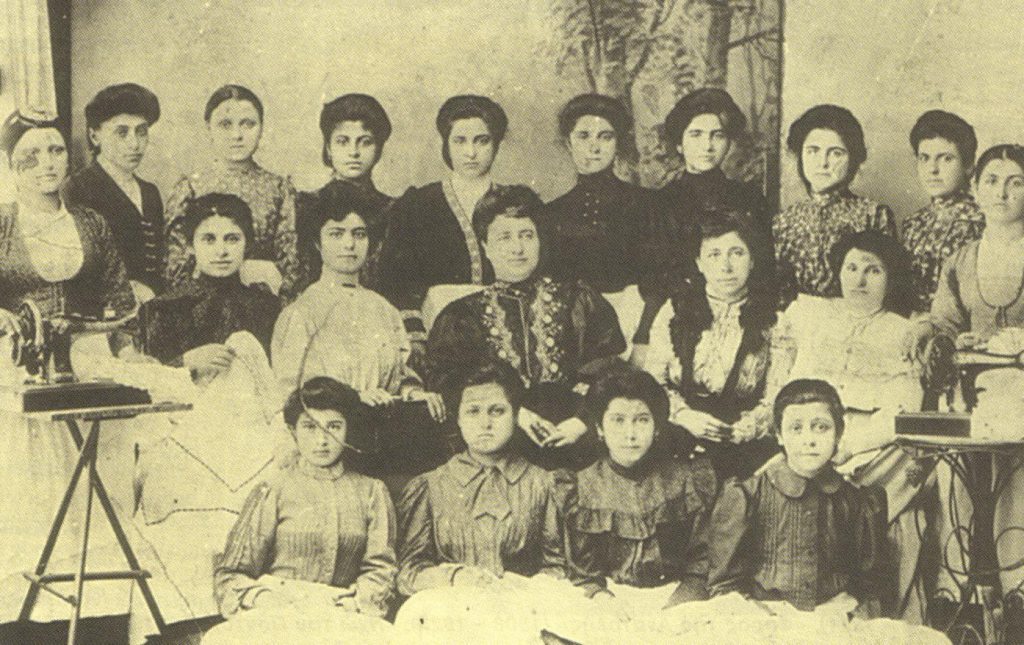
The Muslim population in the western half of the province of Trabzon consisted mainly of Sunni Turks, in the east of Lazes, the Christian population of Greek Orthodox and Armenians. Parts of the Greek and Armenian population were Islamized during the Ottoman rule of the Black Sea region, but preserved their Greek and Armenian languages. During the forced resettlement of the Christian-Greek population (Trk.: rumlar) to Greece in 1923, Islamized Greeks were refused permission to leave the country, even if they so wished.
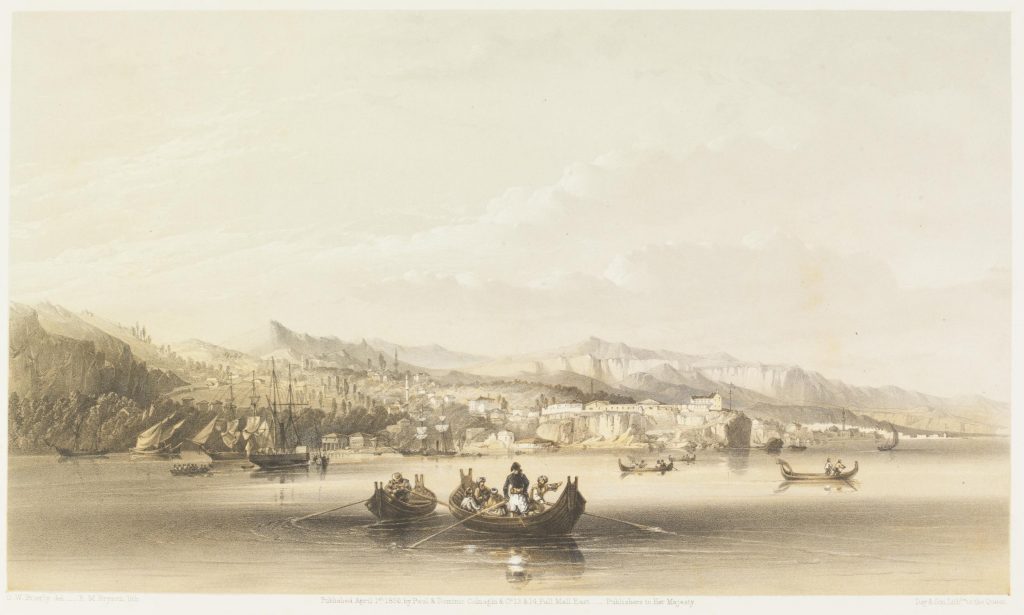
Bryson, Robert M. (lithographer; Source: Victoria and Albert Museum, London; Prints & Drawings Study Room, level D, case SC, shelf 47)
History
The Ottoman province of Trabzon comprised the territories of the ancient regions of Paphlagonia and Pontos. In the second half of the 19th century, the main area of Pontos was made of the vilayet of Trebizond but also comprised parts of the adjoining provinces of Sivas and Erzurum. The northern border of Pontos started to the west of Sinope and stretched as far east as the Russo-Turkish border. The southern border began from Inepolis and ran through Amaseia (Amasya), Tokat, Nikopolis, Argyroupolis (Trk.: Gümüşhane), Paipurt (Bayburt; Arm.: Baberd), the Soganlou Dag mountain range and ended at the Russo-Turkish border.
The region of Pontos was made up of six ecclesiastical provinces, namely Trapezunta, Rodopoleos, Chaldia, Neokaisarea (Niksar), Amaseia and Kolonia.
Greek sailors from Ionia founded secondary colonies in the Mediterranean and Black Sea in the first millennium B.C. These colonies included the present-day cities of Antibes and Marseilles in France, Katania and Messina in Sicily, Ischia and Naples in Campania and Italy respectively. All the cities founded in Pontos – Sinope, Trapezos, Amisos, Kerasus, Rizaion – as well as the cities on the east and north coasts of the Black Sea can be traced back to Ionian colonies, such as Nymphaion near today’s Kerch in Crimea, the ‘twin city’ of Dioscuria – the Abkhazian port and capital Аҟəа (Georgian: Sukhumi) – and the present-day city of Azov on the Azov Sea and the mouth of the Don River, which the Ionians called Tanais. The Roman Cicero compared the Greek coastal towns with a “hem that was attached to the vast fabric of the barbaric lands”.
In their search for mineral resources, Greeks from Asia Minor moved from the coasts of the Aegean, the Sea of Marmara and Pontos to the interior, for example to Cappadocia and Phrygia. The Greeks, who did not come as conquerors but by sea trade routes, often settled in or near more ancient settlements which had existed since the Bronze Age and which were descended from the Hittites, Minoans, Mycenaeans or indigenous peoples.
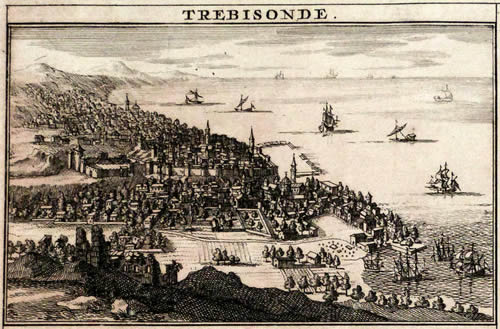
The Pontic Kingdom (281 to 63 B.C.)
Under the rule of originally Persian nobles who adhered to Hellenistic-Iranian cults, the independent kingdom of Pontos had its capital between 283 and 181 B.C. in Amasia (Amasya), followed by Sinope.
The traces of the ancestors of the ancient Pontic (Mithridatic) kings lead to Kios (Gemlik), a small town on the southern shore of the Sea of Marmara in Mysia. The emergence of a Greek-Iranian monarchy had a strong influence on the Pontos and gave it a distinctive identity. However, the name Pontos was probably given to it externally, by the Persians or the Seleucids.
The Mithridatic dynasty, which had its roots in the northwest of Iranian Anatolia, seized power in the confused age after the conquests of Alexander the Great, who had never conquered this part of Anatolia.
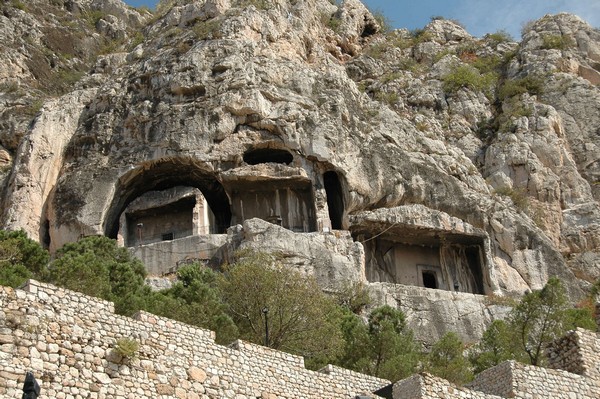
Kings of the Mithridatic Dynasty
| Mithridates I Ktistes | 281 – 266 B.C. |
| Ariobarzanes | 266 – c.250 B.C. |
| Mithridates II | c.250 – c.220 B.C. |
| Mithridates III | c.220 – c.185 B.C. |
| Pharnaces I | c.185 – c.160 B.C. |
| Mithridates IV Philopator | c.160 – c.150 B.C. |
| Mithridates V Euergetes | c.150 – 120 B.C. |
| Mithridates VI Eupator | 120 – 63 B.C. |
| Pharnaces II | 63 – 47 B.C. |
| Darius and Arsaces | 39 – 37 B.C. |
Mithridates I (also Mithradates; ‘Consecrated to the god Mithras’) was the first to call himself king and would be nicknamed Ktistes, ‘founder’. His base was Paphlagonia, in the west of Pontos, but his descendants continued to add Greek ports and regions in the interior, but losing control of Paphlagonia at some point. Pontos could slowly expand because Anatolia had been allotted to the Seleucids, who never gained full control of this part of the former Achaemenid Empire. Instead, the Seleucids preferred a marriage alliance with the Mithridatic kings.
The disempowerment and killing of Mithridates VI Eupator were not the end of the Pontic kingdom, however. While the Romans were fighting their Second Civil War, between Julius Caesar and Gnaeus Pompeius (Pompey), Mithridates’ son Pharnaces II attempted to rebuild Pontic power. He had been too optimistic about his chances. Caesar, who had defeated Pompeius, immediately marched to Anatolia, joined forces with king Deiotares of Galatia, and defeated Pharnaces at Zela.

There were three kings left, belonging to a different dynasty, and ruling in the eastern part of the former Mithridatic kingdom of Pontos:
| Polemon I Eusebes | 37 – 8 BCE |
| Pythodoris | 8 BCE – 38 CE |
| Julius Polemon II | 38 – 68 CE |
In 64 B.C., and as a result of the Third Mithridatic War, Pompey officially annexed Bithynia and the western part of Pontus as the directly governed by the Roman Republic province of Bithynia et Pontus, whereas he added the larger eastern part of the previous Mithridatic kingdom (Armenia Minor, or Lesser Armenia) to the Kingdom of Galatia under the Celtic Roman client king Deiotarus as a reward for his loyalty to Rome. In 159 AD, Bithynia et Pontus became an Imperial Roman province, lasting until 295 AD.
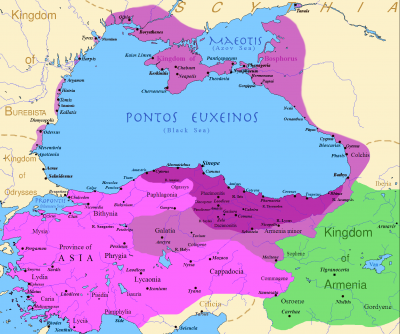
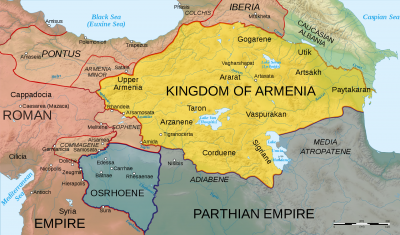
Mithridates VI Eupator (the Great)
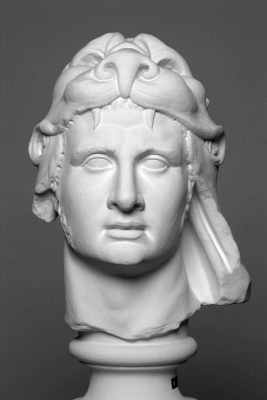
Mithridates V was succeeded by Mithridates VI Eupator (* ca. 132 B.C. in Sinope; † 63 B.C. in Pantikapaion; reigned since 120 B.C.), who was able to conquer Colchis (more or less modern Western Georgia) and the Bosporan Kingdom (the Crimea) and expand his kingdom along the eastern and northern shores of the Black Sea. He also gained control in smaller kingdoms in post-Seleucid Anatolia (Galatia, Cappadocia) and allied himself to Bithynia and Armenia. Having expanded his power base, he embarked upon an anti-Roman policy.
Under Mithridates’ rule, Pontos became the largest and most influential kingdom of Asia Minor. The new king initially expanded his kingdom to include Greek-populated areas in and around Crimea, acting as protector against the steppe nomads. After Mithridates had thus expanded his power base around the Black Sea, he began conquests in Asia Minor. This brought him into conflict with Rome. Because of the exploitation of the Roman province Asia by the Roman tax collectors and the weakness of Rome in the civil war, there were uprisings in Asia Minor. Since Mithridates took advantage of the widespread hatred of the Romans and appeared with the promise of freedom, he met with little resistance. In a first campaign Sulla, Roman governor in Cilicia, succeeded in driving Mithridates from Cappadocia. Shortly afterwards Mithridates formed an alliance with his son-in-law Tigran II (the Great, Տիգրան Մեծ, Grk.: Τιγράνης, 140-55 B.C.) of Armenia. Thus, Mithridates VI was able to control large parts of Asia Minor, the Aegean and Greece, as well as the Bosporan (Crimean) Empire. On his order in 88 B.C., allegedly in one day, about 80,000-150,000 Italic people of Roman citizenship were killed (so-called Vespers of Ephesos).
In 89/88 B.C. the city of Ephesos passed to Mithridates. With the massacre of Ephesos the Pontic ruler intended to eliminate all Italic opposition in that region. At the same time the material expectations of his followers were to be satisfied. Although Mithridates had proclaimed himself as the liberator of the Greeks in the course of his annexationist efforts, he had not succeeded in replenishing his war chest until then. As a worthwhile target group, he identified the Italic people living in Asia Minor, who due to their origin did not adhere to his politics. In addition, these people were wealthy, as they were mainly active in trade and administration. Another reason for the massacre ordered by Mithridates is assumed to be the pent-up hatred of the population of the province Asia against the Roman tax tenants, who had exploited the province for more than 40 years.
The three Mithridatic wars lasted almost 30 years, between 90 and 65 B.C. Gnaeus Pompeius Magnus (the Great) finally defeated Mithridates in 63 B.C. and subsequently put the political order in Asia Minor and Syria on a new basis. Mithridates was pushed back to the Crimea, from where he tried to intervene in Asia Minor again and again in his old age. He was finally deposed by his own family, who negotiated with Rome, in favor of his son.
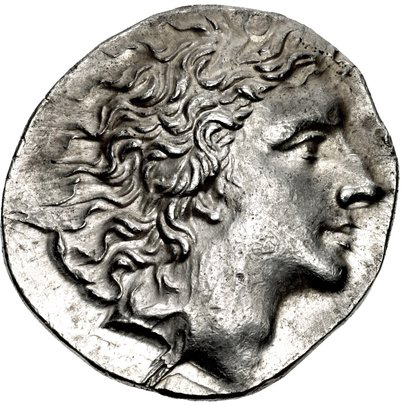
Mithridates VI is also known for his newly developed alloys in coinage, his multilingualism, and his knowledge of botany and pharmacology. He is said to have ruled the 22 peoples he controlled in their respective languages. Ethnic and cultural diversity can also be found in the composition of his royal court: two thirds of the Pontic court are said to have consisted of Greeks from various countries of origin. With Romans, Cappadocians and Thracians, the result is a picture of an international and multicultural court with Greek influence.
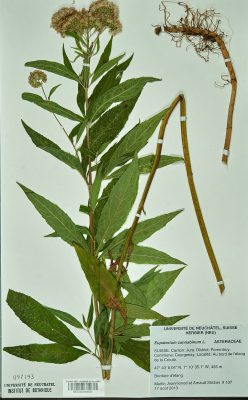
Mithridates studied botany and pharmacology throughout his life. Even today the species hemp agrimony (bot. Eupatorium cannabinum) is named after him. Fearing that his mother might poison him the same way she had poisoned his father, Mithridates developed a complex remedy consisting of 54 ingredients that immunizes against poisoning when taken daily. The king’s knowledge of the universal antidote against poisons, called Mithridaticum, or Mithridate, and the development of a therapy which aims at immunization by a constant intake of small doses of poisons (Mithridatization ) became famous. It is handed down that Mithridates VI was one of the first to create a botanical garden. According to Pliny the Elder Mithridates wrote a book about poisons.
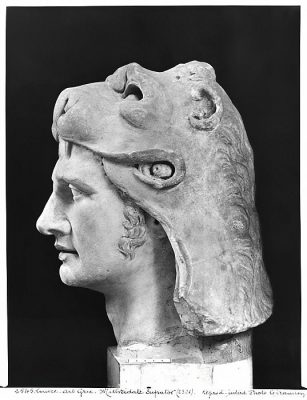
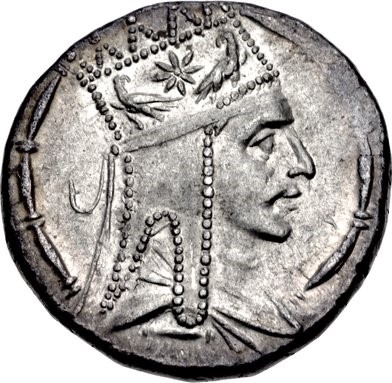
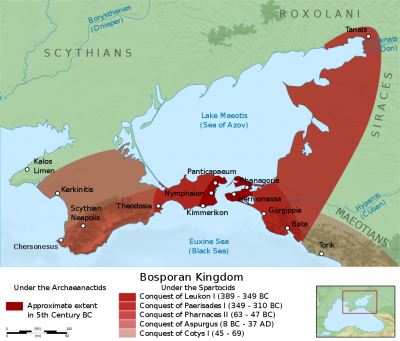
Under Roman and Byzantine Rule
With the subjection of the Mithridatic kingdom by Pompey in 64 BC, the western part of the previous Pontic kingdom was annexed to Bithynia, forming the double province Pontus and Bithynia. This province included only the seaboard between Heraclea (today Ereğli) and Amisus (Samsun), the ora Pontica. The larger part of Pontus, however, was included in the province of Galatia.
Hereafter the name Pontus without additional qualification was regularly employed to denote the eastern half of the province Bithynia et Pontus. The eastern part of the previous Mithridatic kingdom was administered as a client kingdom together with Colchis. Its last king was Iulius or Markus Antonius Polemon II of Cilica (11/12 B.C.-68 A.D.), son of the Pontic queen Antonia Tryphaina, as granddaughter of the Roman commander Markus Antonius an influential personality in the eastern Mediterranean at her time. From 17 to 38 A.D., mother Tryphaina and son Polemon jointly administered the Pontos.
With the reorganization of the provincial system under emperor Diocletian (about 295 A.D.), the Pontic districts were divided up between three smaller, independent provinces within the Dioecesis Pontica:
- Galatian Pontus, also called Diospontus, later renamed Helenopontus by Constantine the Great after his mother Helena. It had its capital at Amisus, and included the cities of Sinope, Amasia, Andres, Ibora, and Zela as well.
- Pontus Polemoniacus, with its capital at Polemonium (previously Fanizan; also called Side; today: Fatsa), and including the cities of Neocaesarea, Argyroupolis, Comana, and Cerasus as well.
- Cappadocian Pontus, with its capital at Trebizond, and including the small ports of Athanae and Rhizaeon. This province extended all the way to Colchis.
Byzantine province and theme
The Byzantine Emperor Justinian I further reorganized the area in 536:
- Pontus Polemoniacus was dissolved, with the western part (Polemonium and Neocaesarea) going to Helenopontus, Comana going to the new province of Armenia II, and the rest (Trebizond and Cerasus) joining the new province of Armenia I Magna with its capital at Justinianopolis.
- Helenopontus gained Polemonium and Neocaesarea, and lost Zela to Armenia II. The provincial governor was relegated to the rank of moderator.
- Paphlagonia absorbed Honorias and was put under a praetor.
By the time of the early Byzantine Empire, Trebizond became a center of culture and scientific learning. In the 7th century, Tychicos of Byzantium returned from Constantinople to establish a school of learning. One of his students was the early Armenian geographer, natural philosopher and polymath Anania of Shirak (Անանիա Շիրակացի; 610-685),who spent eight years at Tychicos’ college.
Under the Byzantine rule, the Pontus came under the Armeniac Theme, with the westernmost parts (Paphlagonia) belonging to the Bucellarian Theme. Progressively, these large early administrative units were sub-divided into smaller ones. By the late 10th century, the Pontus consisted of the two themes of Chaldia (Greek: θέμα Χαλδίας; established by 840), which was governed by the Gabras family, and Koloneia (Greek: θέμα Κολωνείας), which originally was part of the Armeniac Theme. During the Late Middle Ages, the Theme Chaldia formed the core of the Empire of Trebizond until its fall to the Ottoman Empire in 1461. After the 8th century, the area experienced a period of prosperity which was brought to an end only by the Seljuk conquest of Asia Minor in the 1070s and 1080s. Restored to the Byzantine Empire by Alexios I Komnenos, the area was governed effectively by semi-autonomous rulers, like the Gabrades of Trebizond.
The region was secured militarily from the 11th through the 15th centuries with a vast network of sophisticated coastal fortresses.
Tychicos of Byzantium: Founder of the Trebizond Center of Higher Learning in the Seventh Century
Next to Alexandria, Edessa (Urfa) and other cities, Trebizond became an “important centre of higher learning during the early Seventh Century, largely because of the reputation of Tychicus of Byzantium as one of the foremost thinkers and teachers of his day. Widely travelled, Tychicus had studied in Jerusalem, Alexandria, Rome, Constantinople and Athens (where he had studied philosophy for several years) before settling in Trebizond. Invited back to Constantinople to a professorship, he refused and, with the advantage of a substantial library, made Trebizond a teaching magnet. One Armenian, Ananias of Shirak (or Shirakatsi) has left a telling account of his own quest for knowledge which gives us an insight into Seventh Century Armenian learning. As a young man, Ananias, despairing of finding respect for knowledge among the Armenians, set out to travel around Greek centres of learing, seeking out mentors. First, at Theodoupolis, he found Eliazar, but soon exhausted what he could be taught by him. He was directed next to Christodoulos, who lived in the Fourth District of Armenia, and spent six months with him being taught mathematics. Making his way to Constantinople, he met Pelagrius, a deacon of the patriarch, who was about to set out with numerous acolytes to study under Tychicus at Trebizond. Ananias joined this party and went on to spend several years studying under Tychicus, marvelling at the fluency with which he translated into Armenian and being introduced ‘to many writings that were not translated into our tongue’.”
Quoted from: Lowe, Roy; Yasuhara, Yoshihito: The Origins of Higher Learning: Knowledge networks and the early development of universities. London, New York: Routledge, 2017, p. 28
The Empire of Trebizond (1204-1461)
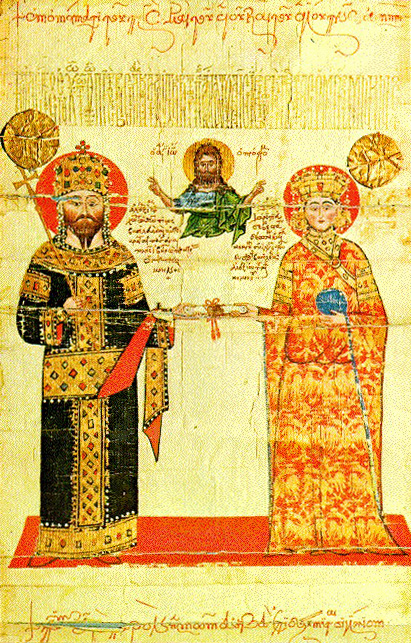
Chrysobull of Dionysiou Monastery on Mount Athos (1374; source: https://en.wikipedia.org/wiki/File:Chrysobull_of_Alexius_III_of_Trebizond.jpg)
The Empire of Trebizond was one of three successor rump states of the Byzantine Empire that flourished during the 13th through 15th. The empire was formed in 1204 with the help of the Georgian queen Tamar (the Great) after the Georgian expedition in Chaldia and Paphlagonia, commanded by Alexios Komnenos a few weeks before the Sack of Constantinople. Alexios later declared himself Emperor and established himself in Trebizond (modern day Trabzon, Turkey). Alexios and David Komnenos, grandsons and last male descendants of deposed Emperor Andronikos I Komnenos, pressed their claims as Roman Emperors against Byzantine Emperor Alexios V Doukas. However, the later Byzantine emperors, as well as Byzantine authors, such as George Pachymeres, Nicephorus Gregoras and to some extent Trapezuntines such as John Lazaropoulos and Basilios Bessarion, regarded the emperors of Trebizond as the ‘princes of the Lazes’, whose possession was misledingly termed Lazica, or ‘Principality of the Lazes’. Thus from the point of view of the Byzantine writers connected with the Laskaris and later with the Palaiologos dynasties, the rulers of Trebizond were not emperors.
After the crusaders of the Fourth Crusade overthrew Alexios V and established a Latin Empire, the Empire of Trebizond became one of three Byzantine successor states to claim the imperial throne, alongside the Empire of Nicaea under the Laskaris family.
Due to its natural harbors, defensible topography and access to silver and copper mines, Trebizond became the pre-eminent Greek colony on the eastern Black Sea shore soon after its founding. The Pontic Alps served as a barrier first to Seljuk Turks and later to Turkoman marauders.
The empire traces its foundation to April 1204, when Alexios Komnenos and his brother David took advantage of the preoccupation of the central Byzantine government with the encampment of the soldiers of the Fourth Crusade outside their walls (June 1203 – mid-April 1204) and seized the city of Trebizond and the surrounding province of Chaldia with troops provided by their relative, Tamar of Georgia. Henceforth, the links between Trebizond and Georgia remained close, but their nature and extent have been disputed. However some scholars believe that the new state was subject to Georgia, at least in the first years of its existence, at the beginning of the 13th century.
The rulers of Trebizond called themselves Megas Komnenos (‘Great Comnenus’) and initially claimed supremacy as ‘Emperor and Autocrat of the Romans’. However, after Michael VIII Palaiologos of Nicaea recaptured Constantinople in 1261, the Komnenian use of the style ‘Emperor’ became a sore point. In 1282, John II Komnenos stripped off his imperial regalia before the walls of Constantinople before entering to marry Michael’s daughter, accepting his legal title of despot. However, his successors used a version of his title, ‘Emperor and Autocrat of the entire East, of the Iberians and the Perateia’ until the Empire’s end in 1461.
Following the death of Alexios II (1297–1330), Trebizond suffered a period of repeated imperial depositions and assassinations. Two groups struggled for ascendency: the Scholaroi, who have been identified as being pro-Byzantine, and the Amytzantarantes, who represented the interests of the native aristocrats (archontes). The years 1347-1348 marked the apex of this lawless period. The Turks took advantage of the weakness of the empire, conquering Oinaion (Ünye) and besieging Trebizond, while the Genoese seized Kerasus (Giresun). Under the rule of Alexios III (reigned 1349–1390), Trebizond was considered an important trade center and was renowned for its great wealth and artistic accomplishment. It was at this point that their famous diplomatic strategy of marrying the princesses of the Grand Komnenos to neighboring Turkish dynasts began.
The Trapezuntine monarchy would survive the longest among the Byzantine successor. The small Empire of Trebizond, which had prospered from maritime trade, was able to survive the fall of Constantinople for another eight years under the protection of the Pontic mountains, but on 15 August 1461 it fell into the hands of the Ottoman conqueror Mehmet II as the last still Christian state of Asia Minor states (the Crimean Principality of Theodoro, an offshoot of Trebizond, lasted even another 14 years, falling to the Ottomans in 1475). Sultan Mehmet banished the last Pontic emperor, David Megas Komnenos, to Adrianoupolis (Thrace), but ordered him to return to Constantinople after two years and to renounce his faith. When David refused, the Sultan had him and David’s three sons decapitated and their bodies thrown to the dogs outside the walls of Constantinople.
Not all Christian nobles possessed the strength of faith and martyrdom of the last Comnenes. Those who could not or did not want to flee after the Ottoman conquest, preserved their privileges and their property only if they accepted Islam. Especially in the 17th century, numerous Georgian, Laz and Pontos Greek aristocrats, together with their serf peasants, converted to Islam.
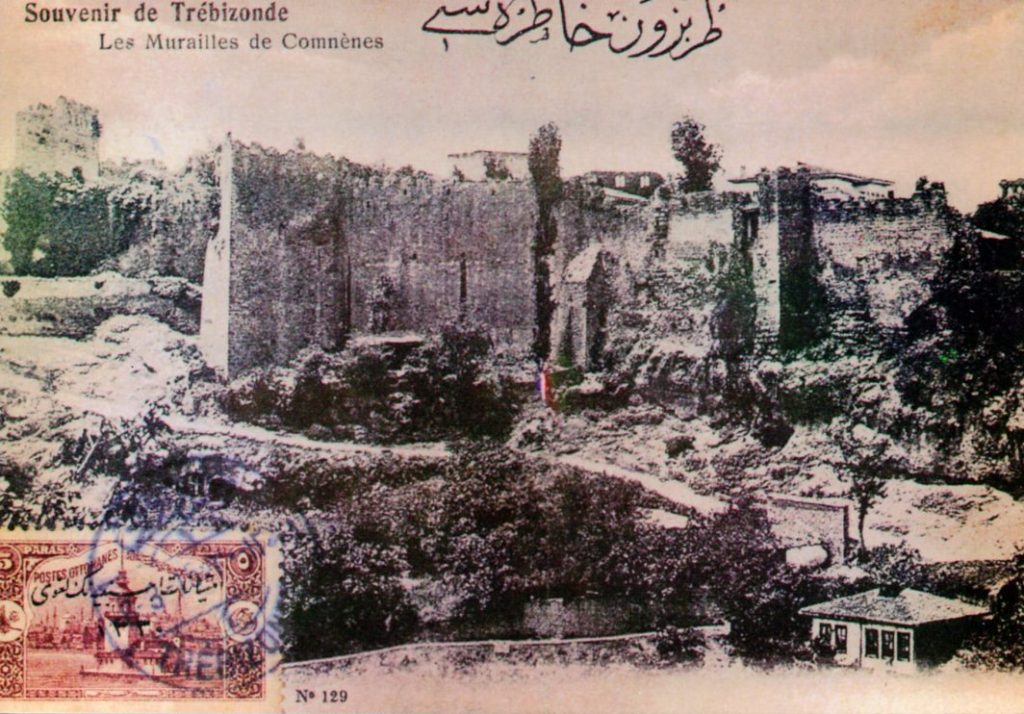
Basileios or Bessarion: “Inter graecos latinissimus, inter latinos graecissimus”
Appreciation
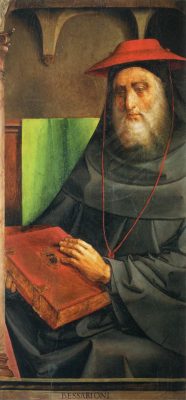
The later cardinal and Latin titular patriarch of Constantinople (1463-1472) Bessarion (monk’s name) was born as Basileios in late 1399 or early 1400 in Trapezounta (Trebizond; Trabzon) and died on 18 November 1472 in Ravenna. He went down in the Church or humanities history as a theologist of unification and a humanist, in particular as a propagator of Plato’s teachings for the western world, rediscovered by his teacher Phleton. Among Bessarion’s numerous theological and philosophical writings are to be mentioned especially the four books of his defensive writing In calumniatorem Platonis (1454; in Latin 1469), written first in Greek, with which Bessarion wanted to put the (neo)Platonic philosophy into the service of the Christian faith.
Bessarion is not only regarded as an altruistic promoter of the idea of church unity, but also as one of the leading scholars of the 15th century. His residence in Rome was a real centre of humanistic scholarship (‘Academy’). The Italian humanist Lorenzo Valla described his patron Bessarion as “the greatest Latin among the Greeks and the greatest Greek among the Latins”.
Praise on Trapezounta / Trebizond
Among the early works of Bessarion is his Greek eulogy Eis Trapezounta to his home town. It offers a detailed, historically and geographically valuable description of the glorified city including the suburbs and the imperial palace on the Acropolis. In contrast to many other cities, Trapezounta is not in decline, but is becoming more and more beautiful. Thanks to its excellent port, the best on the Euxine, the city is an outstanding center of long-distance commerce and craftsmanship is flourishing. Further advantages are the pleasant climate, the fertile soil and the abundance of wood, which is important for ship and house building. The history of the city is dealt with in detail, including the prehistory of its foundation. Bessarion emphasizes that Trapezounta was never conquered by enemies.
Education and life
Bessarion came from simple circumstances. At first, he attended the public school in Trebizond, where his talent was noticed. Then his parents handed him over to the Metropolitan Dositheos of Trebizond to give him a good education. When Dositheos had to leave his metropolitan seat in 1416/17 due to a conflict with the Emperor of Trebizond and went to Constantinople, he took his protégé with him. In the capital of the Byzantine Empire there was no university in the Western sense; secular and spiritual education was in the hands of a cleric, the ‘universal teacher’ (katholikós didáskalos). This office was held by the scholar John Chortasmenos (d. 1431/7). He taught the young Basileios in the school subjects known in the West as the ‘Seven Liberal Arts’ and in ‘Philosophy’, which was understood as Aristotelian logic. These were the fields of knowledge known to the Byzantines as ‘Hellenic’, the knowledge of which made up the ‘pagan’ general education based on the pre-Christian ancient school system (mathḗmata). In addition, there was instruction in the dogmatics of orthodox theology. This was in the early 15th century coined by Palamism, a contemplative orientated direction, which declared the ‘Hellenic’ education, in particular philosophy, to be useless. From it a conflict arose for students eager for education, which Basileios solved for himself in the sense of an affirmation of the pre-Christian antique culture.
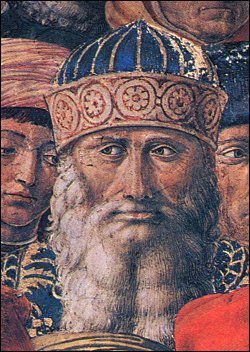
Basileios changed his name to Bessarion when he became a monk in 1423. In 1425 he was ordained a deacon, in 1430 a priest. After his emigration to the Peloponnese (ca. 1431) Bessarion was a student of the philosopher Georgios Gemistos (pseudonym: Plethon; *c. 1355/1360 in Constantinople; † 26 June 1452 or 1454 in Mystras) in Mystra (near ancient Sparta), who taught him philosophy and mathematics. Around 1436, Emperor John VIII appointed Bessarion Abbot of the Basileus Monastery in Constantinople and elevated him to the Metropolitan Throne of Nicaia on 11 November 1437 (hence the common epithet of Cardinal Nicenus).
Pursuing his ecclesiastical career, Bessarion engaged in diplomatic activity in the service of the Byzantine emperor. This put him in contact with the court of the Despot of Mystra. The decisive year in the life of Bessarion was probably 1437, when he was made metropolitan of Nicea and left for Italy as member of the Greek delegation to the Council of Ferrara-Florence (1438/9).
The Council was mainly devoted to an attempt at unifying the Latin and Greek Churches, which the Western European powers had made a condition for providing military support to Palaiologos as he attempted to fend off the Ottoman Turks. As a member of the Greek delegation, the young Bessarion was not eager to concede the main dogmatic point of disagreement between the two churches, which had led to their separation in the eleventh century: the problem of the place of the Holy Spirit in the Creed. According to the Greeks the Spirit proceeded only from the Father, while in the Roman formulation it also proceeded from the Son (Filioque). And yet, driven by his concern for the unstable political situation in Greece and finally convinced by the texts of the Church Fathers, Bessarion changed his mind and in April 1439 pronounced an oration (the Oratio dogmatica de unione) and, after some initial hesitation, became the spokesman for the supporters of an unification of the churches, in which he advocated for agreement between Greek and Latin authors. In July 1439 Bessarion read the act of union between the Roman and the Greek Church in Florence. The same year, while he was in Greece for the last time, Bessarion was made Cardinal.
Appointed Cardinal Presbyter of Santi XII Apostoli on 18 December 1439 by Pope Eugen IV, Bessarion returned in 1440 for a short time to Constantinople, to settle down finally in Italy. Appointed Cardinal Bishop of Sabina by Nicholas V on March 5, 1449, and Cardinal Bishop of Tusculum on April 23, 1449, and successfully active in Bologna as an apostolic legate from 1450 on, all his energy was devoted to the liberation of his homeland and the proclamation of a crusade against the Turks after the fall of Constantinople in 1453. However, Pius II’s efforts at the Congress of Mantua (1459) and Bessarion’s legation to Germany (1460- 1461) failed.
On a legation to Venice Bessarion, who was raised to the Latin Patriarch of Constantinople in May 1463 after the death of Isidoros of Kiev, was able to persuade the Doge to declare war on the Ottomans, but the enterprise was dissolved again by the death of Pius II (15 August 1464). Under his successor Paul II Bessarion cultivated above all his humanistic endeavours.
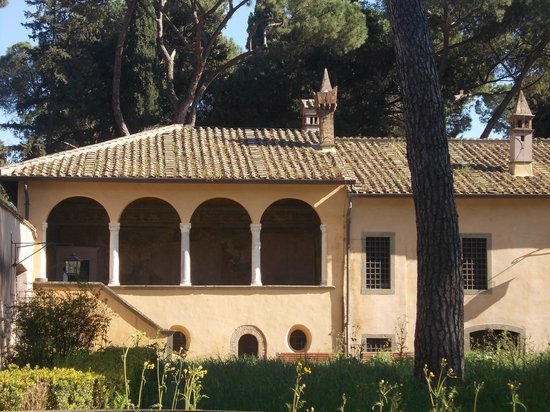
Bessarion would spend the rest of his life as one of the most important and influential members of the Roman Curia. He took particular care of Greek rites abbeys, like those in Calabria, Messina, and Grottaferrata. He obtained a number of benefices, and in 1458 he was selected as protector of the Franciscan Order. In 1463 he also became Patriarch of Constantinople. He even came close to being elevated to the papacy at least twice, but apparently his beard—which for many symbolized his Greek origins—prevented him from garnering the necessary support. His activities as a cardinal were coupled with scholarly enterprises, which he undertook personally, and also sponsored as the patron of a circle of intellectuals who were in many cases Greek emigrés like him. Men like Theodoros Gazis(d. 1476) and Niccolò Perotti (d. 1480)—and for a short period even his nemesis-to-be George of Trebizond (d. 1473 or 1484)—were all part of the Cardinal’s entourage.
After the fall of Constantinople in 1453, Bessarion’s main interest was in rescuing the cultural heritage of his homeland, Greece, and he pursued this goal on both intellectual and political planes. From an intellectual point of view, Bessarion’s plan involved salvaging Greek texts which were until then unknown in Western Christendom and were generally rare (to the extent that in some cases they survive today only in the exemplars collected by the Cardinal). An avid lifelong book collector, Bessarion assembled a library in order to prevent the loss of these treasures: “without books, the tomb would cover the names of men, just as it covers their bodies”. Bessarion feared—indeed he was consumed with terror—“lest all those wonderful books, the product of so much toil and study by the greatest human minds, those very beacons of the earth, should be brought to danger and destruction in an instant”. Bessarion felt that Venice—a city with which he had entertained a long relationship and where he served as papal legate in 1463—could be a safe haven for his library and the important collection of manuscripts he donated to the church of San Marco (Venice) around 1468 formed the first nucleus of the Biblioteca Marciana.
In addition to saving books from destruction, Bessarion had also a more practical political agenda for his homeland; he was among the most vocal advocates for the call for a new crusade to free Greece from Ottoman control. He was therefore engaged in several diplomatic missions, in Germany and then in Vienna, which aimed to convince Western rulers to fight the Turks. After an attempt in 1464 failed because of the death of Pope Pius II in Ancona, Bessarion worked until the end of his days to build support for a project that appeared more and more illusory with every passing year.
Pope Sixtus IV once again sent Bessarion on a diplomatic mission to France to persuade King Louis XI to join a crusade against the Turks (summer/autumn 1472). Returning home seriously ill from the failed legation, the aged cardinal died in Ravenna in November 1472. He was interred in his titular Church, Santi Apostoli in Rome, where the prominent Italian painters Antoniazzo Romano and Melozzo da Forlì had decorated a chapel in his name between 1464 and 1467.
Sources:
- Basil [Cardinal] Bessarion. Stanford Encyclopedia of Philosphy. https://plato.stanford.edu/entries/bessarion/
- Encyclopaedia Britannica. https://www.britannica.com/biography/Bessarion
- Biographisches Lexikon zur Geschichte Südosteuropas: https://www.biolex.ios-regensburg.de/BioLexViewview.php?ID=566
Georgios Trapezountios and Bessarion: The Dispute over Neo-Platonism
Although born in then Venetian ruled Crete, the Greek philosopher Georgios (Gr.: Γεώργιος Τραπεζούντιος, Latin Georgius Trapezountius; George of Trebizond; * 4. April 1395 in Candia, Crete; † 1473 or 1484 in Rome) chose the surname Trapezountios, as his family came from Trebizond. Along with Bessarion, he is considered one of the revivalists of classical Greek literature in Italy and became known as a pugnacious advocate of Aristotle’s philosophy and as a translator of Greek authors. The two central Latin works of the Plato-Aristotle Controversy of the Fifteenth Century were George of Trebizond’s Comparatio Philosophorum Platonis et Aristotelis (1458) and Bessarion’s In Calumniatorem Platonis (Against Plato’s slanderer) in response to George. “With this, Georgios Trapezuntios and Bessarion continued the debate about which of the two ancient Greek philosophers should be given priority. This debate runs (…) like a red thread through the history of Byzantine philosophy.”[7]
Pope Nicholas V entrusted Georgios Trapezountios with the translation into Latin of the Greek writings of Eusebios, Cyril, Chrysostom, Aristotle (Rhetoric), Plato (1451, Laws) and Ptolemy. Trapezountios made word-to-word translations, which at that time were already sharply criticized by humanists, and came into conflict with Bessarion, with Theodoros Gazis, Niccolò Perotti and Poggio. Because of the slovenliness of his work and his presumptuous nature, he forfeited papal favour and had to leave Rome in 1452.
On a trip to Byzantium, Trapezountios probably also made the miserably failed attempt to convert the Ottoman Sultan to Christianity. In his book The Truth of the Christian Faith he is convinced that God desires the ‘unity of all people’, and suggested to the Sultan to renounce violence and to convene a conference of Christians and Muslims.
But Trapezountios’ dispute with Bessarion for and against Plato, which inspired Bessarion to his polemic, only developed after Trapezountios had finally separated from the circle around Bessarion in the 1450s.
The discussion reached its preliminary climax in 1458 with the publication of Trapezountios’ treatise Comparatio philosophorum Platonis et Aristotelis. In this writing he subsumed all common views on Platonic philosophy and conveyed many common prejudices against the Platonists. In the first book he compared Plato with Aristotle in terms of education and in the second book in terms of the compatibility of both philosophical views with Christian teaching. In the course of his argumentation, he made a series of damning judgments both about Plato as a person, whom he rebuked for his voluptas and depravitas (keyword: homosexuality), and about his philosophy, which in his opinion was incompatible with Christian doctrine. Finally, in the third and last book, Georgios was a prophet, a ‘cryer in the desert’, whose duty it was to warn the whole of Western civilization of the dark dangers that, in his eyes, the spread of Plato’s teachings threatened.[8]
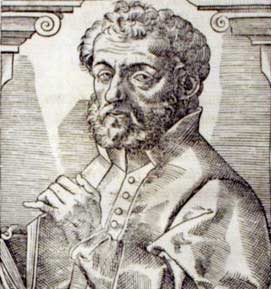
For “until the beginning of the thirties of the 15th century Georgios Trapezountios was an admirer of Plato, whom he had praised as the highest teacher of philosophy (summus philosophie magister) as late as 1426. His turning away from Plato began when he was confronted with his criticism of the great Attic statesmen of the 5th century B.C. (Miltiades, Themistocles, Kimon and Pericles) and of the Rhetoric. His conversion to Roman Catholicism (early 1426) and his service to the Roman Curia made him familiar with
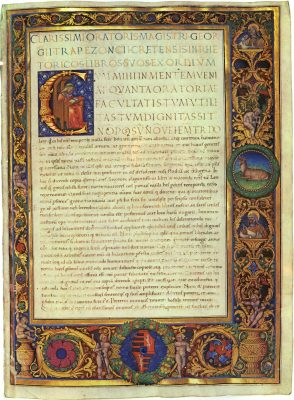
the scholastic theology of the Western Church, dominated by Aristotle. Therefore, the fact that the theology of the Greek Orthodox Church of Byzantium was strongly influenced by Plato seemed to him to be a serious obstacle to the unification of the churches. Islam, which under the leadership of the Ottomans threatened Constantinople (until 1453) and Europe, was also regarded as influenced by Plato. Above all, however, he held Plato’s influence responsible for the new paganism of the Georgios Gemistos Plethon, whom he had met at the Union Council of Ferrara/Florence. Above all, however, he held Plato’s influence responsible for the new paganism of the Georgios Gemistos Plethon, whom he had met at the Union Council of Ferrara/Florence. Over the years Trapezountios believed more and more in a real conspiracy of Platonists to reawaken paganism. Possibly he even suspected Bessarion, because he was a student of Plethon, of being involved in this conspiracy. Since the new paganism influenced by Plato increasingly seemed to him to be a threat, he wanted to warn the Occidentals of this danger and therefore wrote a 1458 published paper with the title Comparatio Philosophorum Aristotelis et Platonis in 1457, in which he tried to prove the superiority of Aristotle over Plato. Trapezountios claimed that Plato and his followers covered up the lack of accuracy and logical coherence of their thinking with enigmatic formulations and wordy language. Only Aristotle managed to create logic. According to Trapezountios, only Aristotle’s teaching is in agreement with that of the Roman Catholic Church. He claims to have already found the Christian doctrine of the Trinity in his writings on heaven. Of course, he finds it difficult to harmonize Aristotle’s ́ doctrine of the eternity of the world with the Christian faith in creation. In this connection he asserts that Aristotle distinguishes between the eternity of the world and the eternity of God as the supreme principle and the first mover of the world, that is to say, Aristotle ascribes to God only an everlasting presence in the actual sense. While Aristotle’s doctrine of the soul is also in complete agreement with the church’s doctrine, Plato taught the pre-existence of the soul. In general, all Christian heresies from Origenes and Arius up to the Palamites of the Eastern Church can be traced back to Plato, whereas the occupation with Aristotle, especially in the Occident, created the most outstanding achievements of Christian theology.”
Quoted from: Todt, Klaus-Peter (Mainz): In Calumniatorem Platonis: Cardinal Johannes Bessarion (ca. 1403-1472) as mediator and defender of Plato’s philosophy. http://www.europa-zentrum-wuerzburg.de/unterseiten/Band12-Todt.pdf
Pontiaká and Romey(i)ka: The Pontic Greek dialect
The term ‘Byzantine Empire’ coined by Hieronymus Wolf as late as the 16th century, was unknown to the citizens of the (Eastern) Roman Empire. The term ‘rum (Plural: rumlar)’, still common in Turkey, refers to the descendants of the Eastern Roman Empire. It can be derived from their self-designation: ancient Greek Ῥωμαῖοι (modern Greek Ρωμαίοι) – Rōmaioi (‘Romans’). Speakers of Pontic Greek thus refer to their language as Romey(i)ka (‘Roman’) or Pontiaká (‘Pontic’). It was and is written with Greek (with the diacritics σ̌ ζ̌ ξ̌ ψ̌ for /ʃ ʒ kʃ pʃ/, α̈ ο̈ for [æ ø]), Latin or Cyrillic letters.
Language or Greek dialect?
The linguistic, lexical and grammatical features of Pontic Greek are so pronounced that Pontiaka or Romey(i)ka almost seems to be a language in its own right. It is hardly understood not only by Greeks in Greece today. Greeks from other regions of Asia Minor also had difficulties with it (cf. the quotation from Elias Venezis’ memoirs recorded close to events). The reasons for these difficulties of understanding lie in the geographical isolation of Pontos, where the Attic-Koiné Greek of the Greek colonists developed separately from the rest of the Greek language for almost two millennia; it thus preserved elements of Ancient Greek that are no longer found in today’s standard Greek.
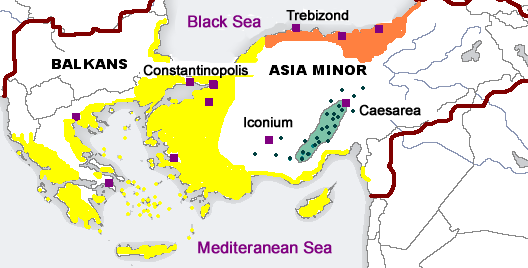
At the same time, Pontic Greek was exposed to numerous influences from neighbouring cultures and changing systems of rule: Iranian (Persian, Parthian), South Caucasian (Laz) languages, Armenian, as well as Byzantine Greek and Ottoman Turkish.
Sub-dialects and historic distribution
Similar to most modern Greek dialects, Pontic Greek is mainly derived from Koiné Greek, which was spoken in the Hellenistic and Roman times between the 4th century B.C. and the 4th century AD. Following the Seljuk invasion of Asia Minor during the 11th century AD, Pontos became isolated from many of the regions of the Byzantine Empire.
The Greek linguist Manolis Triantafyllidis (1883-1959) distinguishes between a western group of Pontos Greek (Oinuntian or Niotic, around Oinoe (Turkish: Ünye), an eastern coastal group ( Trapezuntian, around Trabzon), and Chaldian, which was spoken in the eastern hinterland (around Gümüşhane); most speakers lived in Chaldia.
Ophitic/Romeyka
The inhabitants of the Of valley who had converted to Islam in the 17th century remained in Turkey after the forcible population ‘exchange’ of 1923 and have partly retained the Pontic language until today. Their dialect, which forms part of the Trapezountiac subgroup, is called ‘Ophitic’ by linguists, but speakers generally call it Romeyka. As few as 5,000 people are reported to speak it. There are however estimates that show the real number of the speakers as considerably higher. Speakers of Ophitic/Romeyka are concentrated in the eastern districts of Trabzon province: Çaykara (Katohor), Dernekpazarı (Kondu), Sürmene (Sourmena) and Köprübaşı (Göneşera). Although less widespread, it is still spoken in some remote villages of the Of district itself. It is also spoken in the western İkizdere (Dipotamos) district of Rize province. Historically the dialect was spoken in a wider area, stretching further east to the port town of Athina (Pazar).
Ophitic has retained the infinitive, which is present in Ancient Greek but has been lost in other variants of Modern Greek; it has therefore been characterized as ‘archaic’ or conservative (even in comparison with other Pontic dialects) and as the living language that is closest to Ancient Greek.
A very similar dialect is spoken by descendants of Christians from the Of valley (especially from Kondu) now living in Greece in the village of Nea Trapezounta, Pieria, Central Macedonia, with about 400 speakers.
Ioanna Sitaridou, a linguist of Pontic Greek descent, calls the Pontic Greek dialect, which is still spoken by about 5,000 people in the Trabzon area, Romeyka. In its sentence structures as well as in many vocabulary, this language, which is spoken by Islamicized Greeks, has been able to preserve its archaic elements most strongly, since its speakers separated themselves from the Christian Pontic Greeks and were no longer exposed to the influences of the liturgical language due to their change of faith.
Due to the forced resettlement of the Christian Pontic Greeks in accordance with the Lausanne Treaty (1923), speakers of Pontic Greek were brought to the Republic of Greece, where their children were not taught Pontic Greek in schools, but Standard Greek. Many second and third generation Pontians who grew up in Greece also remember with pain and anger how they were discriminated against and ridiculed for their dialect by Greek school teachers and non-Pontic classmates.
Though Pontic was originally spoken on the southern shores of the Black Sea, from the 18th and 19th century and on substantial numbers migrated into the northern and eastern shores, into the Russian Empire. Pontic is still spoken by large numbers of people in Ukraine, mainly in Mariupol, but also in other parts of Ukraine such as the Odessa and Donetsk region, in Russia (around Stavropol) and Georgia. The language enjoyed some use as a literary medium in the 1930s. Among other things, a school grammar was written down (Konstantinos Topkharas, 1998 [1932]), which explains Pontic grammar in Pontic language. In these areas, Pontic Greek is considered the most vital today, although large parts of the speaker populations migrate to Greece.
Outside Turkey and Greece one can distinguish the following sub-dialects:
- the Northern group (Mariupol Greek or Rumeíka), originally spoken in Crimea, but now principally in Mariupol, where the majority of Crimean Pontic Greeks of the Rumaiic subgroup now live. Other Pontic Greeks speak Crimean Tatar as their mother tongue, and are classified as “Urums“. There are approximately half a dozen dialects of Crimean (Mariupolitan) Pontic Greek spoken.
- Soviet Rumaiic, a Soviet variant of the Pontic Greek language spoken by the Pontic Greek population of the Soviet Union.
Today’s distribution
The number of speakers of Pontic Greek has been estimated at 300,000-778,000 for the period around 2015, of which about 400,000 are located in Greece (where Pontiaka and Rumeyika have no official status).
In 1989, 40,000 speakers lived in Russia, including 15,000 each in the Krasnodar region and near Stavropol. In Georgia, 60,000 speakers were reported at that time, and 2,500 speakers lived in Armenia. The Pontic Greek dialects in the Georgian Tsalka and the Armenian Alaverdi regions were partly derived from Greek dialects of Cappadocia, which were presumably assimilated from Pontic Greek.
Endangered language
In its latest edition of the Atlas of the World’s Languages in Danger (2010; updated 2017), UNESCO estimates the number of speakers of Pontic Greek at 300,000, with Armenia, Georgia, Greece, the Russian Federation, Turkey and Ukraine as the distribution areas. It classifies Pontic Greek as a language definitely threatened with extinction because the speakers (according to this classification by UNESCO), with the exception of a few half speakers and linguists, are only older speakers and there is no transmission of the language to the younger generation.
In Greece, the youth of Pontic origin often speak standard Greek as their first language. The use of Pontic has been maintained more by speakers in North America than it has in Greece.
Literature and music
Pontic Greek has a rich oral tradition. The Pontic Greek songs, also referred to as ‘Pontiaká’, are particularly popular in Greece and among the local Pontic community. There is also some limited production of modern literature in Pontiaka, including poetry collections (among the most renowned writers is Kostas Diamantidis), novels, and translated Asterix comic albums.
Wikipedia in Pontic Greek – Η Βικιπαίδεια σα Ποντιακά τα Ρωμαίικα τη Πόντονος
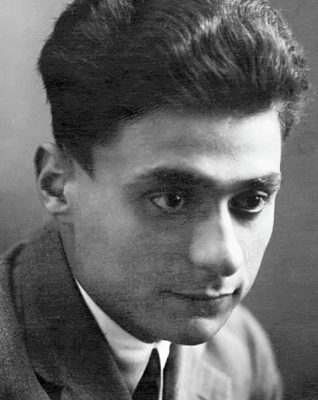
Elias Venezis: “Very funny was their Greek”
At the age of just 18, the later Greek novelist Elias Venezis (Gr.: Ηλίας Βενέζης; i. e. Elias Mellos; March 4, 1904 – August 3, 1973) was deported by the Kemalist rulers to a concentration camp for Greek forced laborers (of Ottoman nationality). He published his memoirs of this time event-close under the title Number 31328 (Το Νούμερο 31328; 1924; 1931). In the 15th chapter of this autobiographical work, Venezis (who himself came from the Ionian city Ayvalık (Gr.: Kydonies)) describes the arrival of Pontic Greek forced laborers in this camp. At the same time, his description hints at the pronounced regionalism and the pecularities of the Pontic Greeks:
“While this affliction united us ever more closely, a group of companions stood apart, the Ambrosians and Pegasians, about fifty men. They were brought from the Ankara work battalion.They were Greeks from the Sivas area, down near Trapezunt. They’d been working 3 or 4 years longer than us in the work battalions. The Hellenic army had not penetrated into their area. But the Turks had drafted them and used them for stone cutting. They differed from us in that they wore costumes that had not been taken from them. It was a kind of harsher dress; the pants first bulge out a little and then close tightly around the calves. In the good times, these people roamed all over Anatolia. ‘Cotton pads we fix, quilts we mend’. And when they weren’t pounding stones, they’d turn the spindle from dawn till dusk. Even on the road, when we went to forced labor, they wouldn’t let the spindle rest. Most of them had names like Ambrosios or Pegasios.
Very funny was their Greek. They could not suppress the voiced n, always put the verb at the end as in the Turkish syntax and mixed Greek with Turkish words.
They all slept in the same accommodation, did not separate from each other, did not mix between us. If one of them stepped out of line and was late to join them, they would all step outside the door together and call out. Then they went around the other shelters and asked:
Have you seen the Pegasios? Have you seen the Ambrosios?
Some jokers from Smyrna, from among our own, held them up. Then, for a brief while, there was a merriment.”
Ποντιακή λύρα – Pontiaki Lyra – The Pontic Fiddle (Gr.: Kementsé; Tr.: Kemençe)
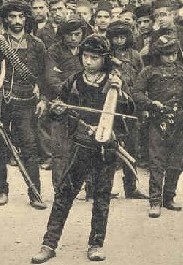
The string instrument lyre is a Greek invention. From ancient Greek mythology we learn that the god Hermes made the first lyre: from animal armor and three branches which he stretched into “sweet sounding strings”.
The lyre went through several stages of development during its 5,000-year history. Its first name was Phyrminx. Probably the 4-string Phyrminx was called Lyra of Hermes. The following changes to the lyre involved increasing the number of strings and modifications to the shape of the sounding body. From the 10th to the 15th century A.D. this instrument was called fiddle in Europe. In the 15th century AD the name ‘lyre’ reappeared. A family of lyras of different size, shape and number of strings was created. One of these lyras was the lyra da braccio. After its perfection by Italian artists it was called violin.
The Lyra in the Pontos
However, the Black Sea Greeks simplified the instrument again, and this variant was called the Pontic lyra. An even earlier emergence of the simple Pontic lyra, for example at the time of the development of the ‘fiddle’, cannot be completely ruled out. The Greek Pontians called the 3-string lyra Kementsés and the 8-string Kemanés. The kemanés has five strings at the top and three below these five. The bow plays only the five upper strings and thus makes the lower ones vibrate. The reasons for the equation of lyra and kementsés are probably the same number of strings and the same way of playing them and holding the bow. But also the mixture of languages caused by the contacts between Greek Pontians and the Ottoman people may have played a role. The fact that in Pontic tradition one and the same person plays the lyre, sings and dances clearly shows the influences of musical customs in ancient Greece.
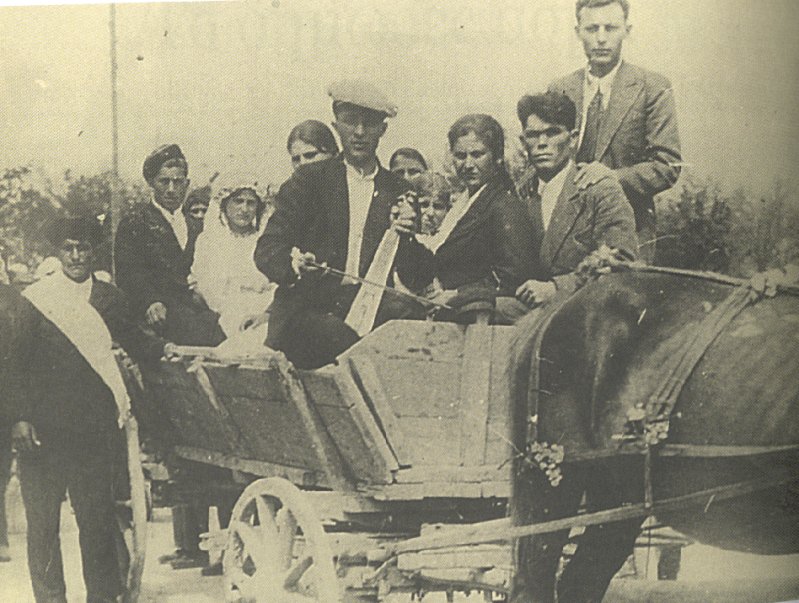
The Kementsés with its elongated shape, on the other hand, is adapted to the Anatolian way of playing, in which the player sits and crosses his legs. The shape of this instrument excludes playing in an upright position, as is typical for the Pontic lyre. It is without doubt the musical instrument that defines Pontic culture, and has a very distinct melody unlike any other instrument, used in Pontos. It has significant symbolic value for Pontic Greeks and serves as a symbol of their cultural identity.
The Pontic lyra comprises a narrow box shaped body which includes a neck and a pegbox, and a soundboard which covers the body. The body is either made by hollowing out a single piece of wood, or by gluing pieces together. The best lyra are said to be made of extremely dense wood such as cherry, plum, mulberry, walnut or juniper wood. Cedar is sometimes used. The soundboard is made of pine or spruce.
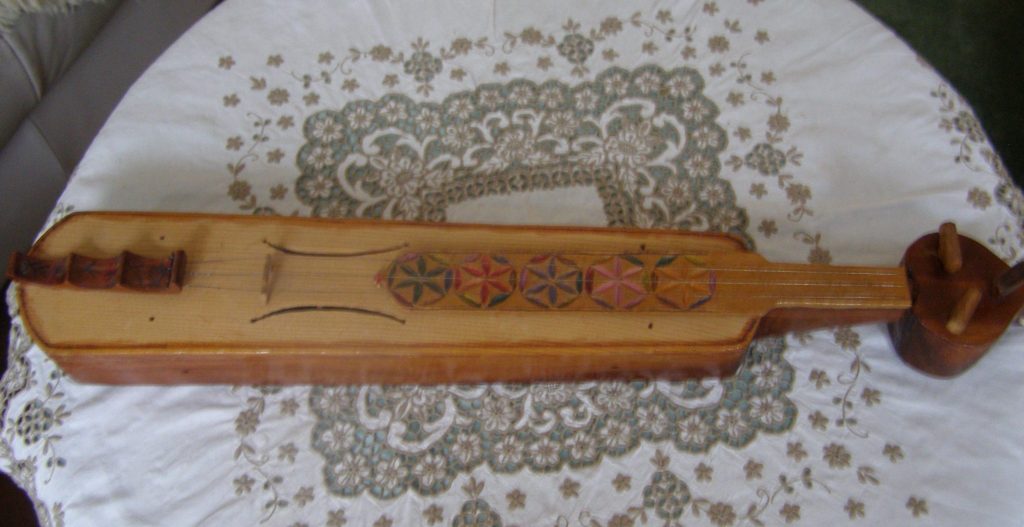
The sides of the body are generally 2-3mm in thickness, as is the soundboard. The pegs are made of hardwood (usually the same wood as the body) and are inserted from the front. Until around 1920, some, or all of the three strings were made of silk. However, silk strings produce a beautiful but weak sound. Silk made way for gut strings and subsequently replaced by metal strings.
Traditionally, the bow (doksar) was made from an olive branch however nowadays it’s made from any light piece of wood. Hair from a male horse’s tail was used historically. Nowadays bows with synthetic hair are more commonly used. While playing, the tension of the bow hair is controlled by the second and third finger while it is held palm upwards.
The instrument can be played while standing up or sitting down and is held vertically. When seated, the bottom of the lyra is rested between the thighs of the player. The chords are touched with the flesh of the fingers, not the nails. There is no vibrato. A particular characteristic of the Pontic lyra is its polyphony in which drone effects and parallel fourths dominate. Wrist movement is also used especially in faster paced tunes.
Two classes of kementsés (kemenche) differing in size have been distinguished, but local Black Sea Turks did not differentiate them. The smaller ones, around 54 cm in length, often have a fingerboard and the larger instruments are around 68 cm in length. Also, the kemane of Cappadocia, is a type of ‘large kemenche’, which, as seen in Turkish Museums, have six strings with a further six sympathetic strings under the fingerboards.
In contrast to the kementsé, or kemenche, according to the Greek kemane player, George Poulantzaklis, the kemane is between 55 cm and 70 cm in length and only larger in volume and shape than the kemenche. The instruments Poulantzaklis uses have four strings with four other strings (sympathetica) which create a vibration (clamour) to the first four.
The kemenche is one of the four basic types of lyra. The other three, the Cretan lyra, the lyra of the Dodekanisa and the Thrakian lyra, are pear-shaped with three or four metal or gut strings which are stopped from the side by the fingernails (which differs from the kemenche where strings are stopped by the finger tips). Small pellet-bells attached on the bow (which provide rhythmic accompaniment), on the pear-shaped lyra, were once common (until around World War II), but are now rare.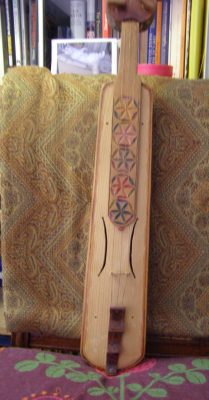
History
The origin and history of the kemenche are obscure. The earliest known representation of a kemenche appears to be in an album of watercolors of Constantinople painted by Amedeo Preziosi. The Maltese Preziosi was active in Constantinople from about 1840 onwards and was the chief figure in the Ottoman art world in the 1870s.
Matthaios Tsahourides, researcher and respected kemenche player, believes the instrument (which he prefers to call the Pontic lyra) and its music has similar roots in Medieval Europe and Byzantium. If the construction of the instrument with other European instruments is examined, the kemenche looks more like a Byzantine or Medieval European instrument, than an instrument of Asian origin.
The kemenche was taken to the South Caucasus in the last half of the 19th century and the first quarter of the 20th century by Pontic immigrants and refugees.
The word kemenche is believed to be derived from the Persian words keman (bow) and che (little). The kamancheh or kamāncha is a Persian bowed string instrument related to the bowed rebab
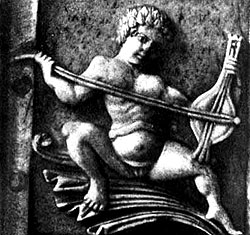
(the historical ancestor of the kamancheh), and also to the bowed Byzantine lira which is an ancestor of the European violin family. Other variations of the kemenche are the Kemona and the Kemane.
Geographically the Pontic lyra was played only in the areas which once bordered the Byzantine Empire of Trebizond (from Samsun to just east of Trabzon, and also inland). Today, in this region situated in north-eastern Turkey, the kemenche is still made by local luthiers and played extensively and is referred to as Karadeniz kemençesi. However, the Karadeniz kemençesi is a slightly lighter instrument due to its lower depth. It also has fewer sound holes and therefore sounds slightly different. The instrument is generally not played in other parts of Turkey.
The Rum (Orthodox Greeks) who lived in this region for nearly 3000 years, and who were expelled in 1923 as part of the forcible exchange of populations between Greece and Turkey, sometimes simply call the instrument a ‘lyra’.
Source: Sam Topalidis (2010): The Kemenche – https://pontosworld.com/index.php/music/iistruments/326-the-kemenche-2
The Pontic Lyra (Kemenche) – https://pontosworld.com/index.php/music/iistruments/331-the-pontic-lyra
Playing the Pontic Lyra:
(Tik Santas)
Serra (Horon), Kótsari (Κότσαρι) and many others: The dances of the Pontic Greeks
Folklore in mountain regions is always diversified. Traditional costumes, dances, songs, but also dialects differ from valley to valley. This also applies to the Pontos.
Today 50 to 80 Pontic dances are known. Some of them are widespread and were and are danced everywhere, but there are also some that are hardly known. Each region of the Pontos had its own specific regional dances.
The Pontic dances have their origin in the dances of ancient Greece, many of which were dedicated to specific deities. They are social dances, which – depending on the occasion – have different dance emphases; they are divided into warlike, religious-ritual and peaceful dances. Their social character is shown by the fact that they are circle and group dances. They are of great importance to the Pontic Greeks because they helped to maintain their tradition and identity, both in the Pontos under Ottoman rule and in exile after the ‘uprooting’ in 1923.
In the Pontic dances, together with the dancing people, the lyricist also takes part. In the dances, which are accompanied by his song, he himself dances with his lyre. He runs from one end to the other, from one dancer to the other, he jumps in rhythm with the dancers and shows an uncontrolled, enthusiastic, Dionysian side.
Most Pontic dances were pure male or female dances. There were only a few mixed dances, which were danced only on special occasions. For example Kotsagél, which is danced at a wedding as the last dance by all relatives of the bridal couple, or the so-called Kodespiniaká dances, which were called that because they were danced by adult men and women and sometimes even led by a woman (Kodéspina = mistress; lady of the house). The Omál, the Dipát and the Tik belong to the Kodespiniaká. Today all dances are danced mixed, except the Pyrrhíchios, which was and is only danced by men (or women in men’s costume).
The majority of Pontic society was rural. So we know many peaceful peasant dances, for example Trygóna, Kótsari, Saríkus. The religious-ritual dances revealed the loyalty of the Pontians to their customs and traditions and the respect for the values of the society they lived in. The religious-ritual dances include the wedding dances such as Thímisma and Kotsagél. The only martial dance is the Pyrrhíchios.
The Pontic dance is a group dance, and there are no distinction of location or class, no best or worst. The circle of dancers unites all together and the ‘I’ merges into the ‘we’. The first becomes the last and the last the first in the dance circle.
The Horon (Serra; Lazikon)
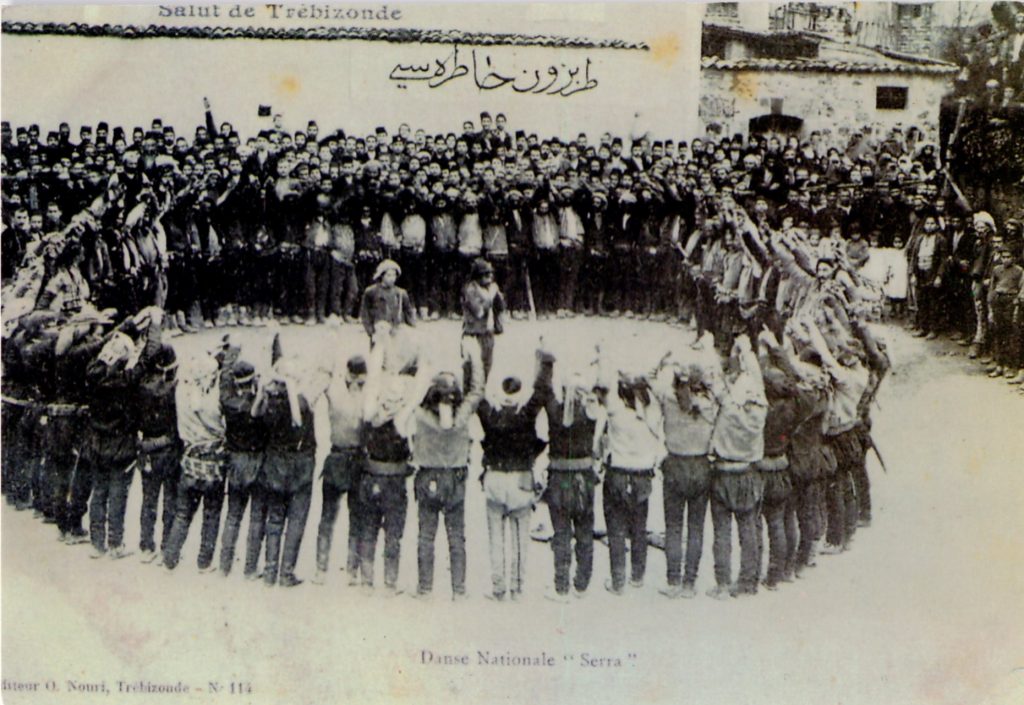
Probably the most archaic and well-known dance is Horon (also: Khoron; Horonu; from Greek choros (χορός) – ‘choir’, ‘dance’) or Ser(r)a (probably after the river of the same name west of the city of Platana [Tr.: Akçaabat]).
This dance is also referred to as the Pyrrichio or Lazikon. The ancient origins of the dance can be proven as the dance moves resemble those of the ancient Pyrrhic dance.
According to Plato, Pyrrhíchios means ‘Armed Dance’, a dance symbolizing war, in the course of which attack and defense are represented. Plato considered it essential that women and girls, as well as men and boys, should practice the dance of arms and warfare. He points out “that there are countless masses of women on the Pontos, called Sauromantes, who are prescribed the same exercises and performances as men, not only in riding, but also in archery and the other arts of arms”. (Plato, Laws, Book 7)
Then as now, Pyrrhíchios is danced in two ways: one is when two men armed with knives circle each other with dancing movements, they wrestle and try to defeat each other. This version is still danced today under the name ‘Mazér’ (from Greek “machéri” = knife). In the second version the warrior-dancers hold each other’s hands in a round dance. They are armed and ready for a joint fight. This kind of Pyrrhíchios is danced today under the name Sérra.
In the periodical Pontiaki Estia (1956, 4th edition, #76) Mouzenidis states that the Serra is a dramatic dance and analyses it as follows:
Firstly the dance comprises 3 parts. In the first part the dancers who are characterizing the people (laos) as a whole, hold each other by the hand and with arms raised begin to dance slowly with a mood of joy expressed on their faces. Gradually the dance moves into the 2nd part. Joy turns to unease and the dancers’ bodies increase intensity their hands moving rhythmically forward and then backward attempting to keep their bodies upright so as not to fall. At this point the dancer is trying to mimic an injured fighter trying to cling to life and to win. And although the body is leaning over, small energetic and sudden movements show the wounded fighter is trying to survive. In the 3rd phase redemption arrives. The dancer’s body which was bent over and almost touching the ground gains strength and the dancer begins to jump with his legs spread wide apart and his body becomes erect like a column and his head is held up with pride and looking upwards.
K. Papamihalopoulos in his work titled A tour of Pontus (1904) wrote the following about the Serra after touring the region and seeing the dance in person:
It is a war dance characterized by directional body movements by dancers that are joined tightly together. The dance consists of violent movements of the body, strong foot taps on the floor, contractions of body muscles, an enthusiasm and cheerfulness that grips the dancer, and a spark which transmits emotion. A dance identified by its originality and splendor of a group which quite rightly classifies it as one of the most famous dances in the entire world. [9]
The Pyrrhic Dance
The Pyrrhic dance, which the Serra is based on, was an armed dance of ancient Greek origin. The exact steps are not known but the movement was definitely quick and combat-like. According to Strabo (Gr.: Strávonas), an ancient geographer and historian from the Pontic city auf Amásia, the origins of the dance and also its name comes from the contorted movements in the death of Achilles’ son Pyrrhus as described by Euripides in Andromache.
A more likely argument is that the Pyrrhic’s birthplace was in Crete due to its association to the myth of the Curetes guarding infant Zeus with warlike movements and noises of clashing swords and shields. By 1250 B.C. the dance was widespread in Crete, mainland Greece and Asia Minor. It is mentioned in the Iliad (8th century B.C.) where it’s suggested the name derives from pyra (pyre) or pyr meaning fire.[10]
The Kótsari (Ko(t)chari)
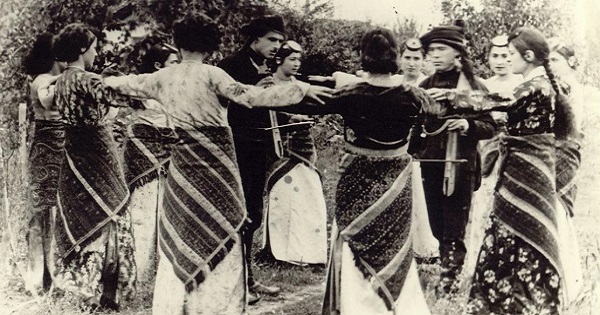
Although the Kochari (or Kotchari; in Greek pronunciation Kotsari; Grk.: Κότσαρι) is a popular dance amongst Pontic Greeks second only in popularity to the Serra, it seems to be an import from the South Caucasus, namely from neighboring Armenia. It was danced in the eastern regions of Pontos such as Argyroupolis (Gümüşhane), Bayburt (Arm.: Baberd) and primarily by the Pontic people of Kars, the ancient capital city of the Armenian Bagratid Kingdom. It was also danced in the Upper Matsouka region. The dance was introduced to the Upper Matsoukans as late as in the last decades prior to the forcible population Exchange (1923) and it’s sometimes said that the Matsoukans learnt the dance at the festivals of Panagia Soumela from worshippers who originated from the home of the dance, i.e. those from the easternmost regions of Pontos and the Caucasus.[11]
There is an Armenian and a Greek ethymology for the origin and the name of this group dance: Ko(t)chari (from Armenian ‘քոչէլ’ (ko(t)chel – to move around; to nomadize) is a shepherd dance, which has been registered on the UNESCO World Heritage List since 2017.[12]
Jannis Korosidis characterizes the Pontic Greek variant of the Ko(t)chari as follows:
„This dance is danced by the rural population in the south of the Pontos, especially by the Pontic Greeks of the Caucasus. Its name refers to the Pontic word for ram, the billy goat, the sacred animal in the worship of Dionysos. The fast, springy, double-footed movements of the dancers remind us of the jumps of the billy goat during the rut, at the beginning of spring, the time of the religious veneration of Dionysos. The worship of the god who was originally the patron saint of the farmers is also recalled by the first steps of the dance, which were performed by the dancers to get onto the stage as early as in ancient times.
‘Stamátima’, a typical figure in Kótsari, a short ‘behaviour’ during the dance, is considered an element of ancient religious worship and has been preserved in the Pontic dance tradition until today. During their magical services, the dancers suddenly stopped and then started again with the aim of attracting the attention of the audience or the worshipped deity.”[13]
Diverging explanations are quoted in the dance’s description by Pontosworld:
“Its name is derived from the manner in which it’s danced and in particular the 2 limp movements (the first 4 steps of the dance), which are executed with synchronous stepping of the heel (the kotsi) on the ground. In Greek, the word koutso means limp, and the heel of the foot is called the kotsi (pl. kotsia).
Another explanation of the name is that it describes the manner in which the legs-knees are shaken and locked by metatarsal movement. The dance relies on powerful foot movement/limps and hence it’s the dancer’s feet which keep the dancer upright. Whilst the above descriptions are considered arbitrary another explanation is that it was named after an anonymous dancer by the name of Kotsari (or Konstantinos) although this explanation does seem unlikely.
The Kotsari belongs to the family of straight step heel dances which rely on heel steps. Such dances also exist in Greece, the Aegean islands, Crete and generally amongst the races of Asia minor since Ancient times.
It’s a double rhythm fast dance similar to the Susta dance of Rhodes and the Maleviziotic-Castrino dance of Crete. The dancers hold each other at the shoulder in a circle but more commonly in a semi-circle. There are 8 steps in the dance which are broken down into 2 parts. The first 4 movements are the 2 on the spot jumps, in other words the limp steps of the left heel – this is the first part of the dance. The next 4 steps are basic ones and move the dancer towards the right.
The dance started off as a male only dance. Some researchers have classified it as a mountain war dance. Later it became acceptable for women to dance it also.”[14]
Customs and Traditions of the Pontic Greeks
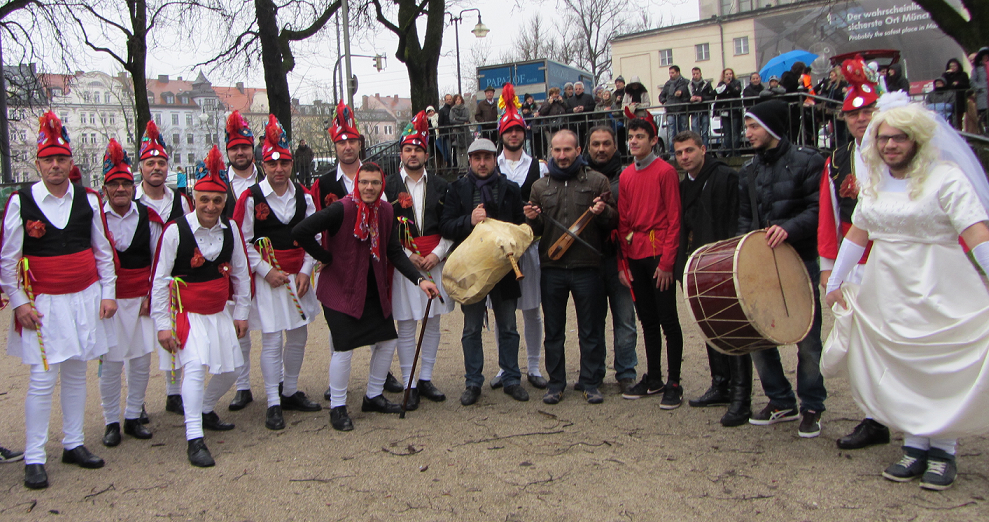
The Momogeri
The Momogeri are magical and religious celebrations that took place in Pontos between Christmas and the feast of Epiphany (feast of the Apparition of the Lord; in the West this day coincides with the feast of the Magi). On the day of the Epiphany the performances came to an end, as the evil winter spirits were driven out with the apparition of the Lord.
Momos was in ancient times the Greek god of nagging, the personification of rebuke and defamation, a master of sharp-tongued criticism who did not even stop at the gods. The priests of the god Momos are called Momogeri or his followers, who mock people and events by dancing and singing.
Around 400 A.D., Bishop Asterios of Amasseia (city in Pontos; today’s Amasya in Turkey) reports about a celebration in which people dressed up on January 1st.
These celebrations are connected with the celebrations of the god Dionysos in ancient Hellas and have in common, apart from mockery, the disguise and masquerade. The Momogeri are self-staged performances by disguised theatre groups, which were played in the courtyards, at street crossings or in central squares. The disguise with animal skins, horns, fox and hare tails, is evidence of the ancient origin of some of the figures. The use of face coverings and animal skins is widespread in all ancient cultures. The masked man equates himself with the deity to whom the holy animal belongs. Likewise, the dried fruits, herbs, fruit and other symbols of fertility worn around the neck by some theatre group members or the use of sticks by the leader of the theatre group bear witness to the magical and symbolic origin of these celebrations.
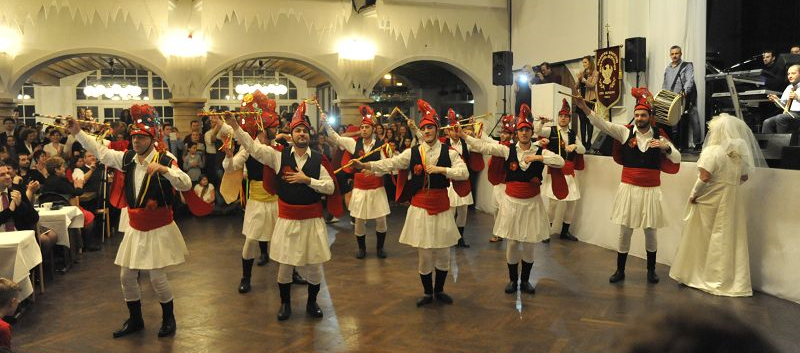
Usually the theatre group was formed by young people originating from the same village. The performances were always accompanied by music players. Dance and singing were integral parts of each performance.
The content of the performances is usually humorous, which is why the Momogeri are sometimes called comedy. However, comedy sometimes took on social dimensions and served to attack the corruption and licentiousness of the conquerors (Ottomans).
One of the main roles in the performances is played by the bride, who symbolises the vegetation and fertility of the earth. The confrontation between two men, a young man and an old man (the young man embodies the new year, the old man the past year), with the aim of winning the bride and, finally, the victory of the younger man are remnants of the ancient origins. In the performances there is also often the healing of an injured person or the resurrection of a deceased person, as well as dancing and a happy ending.
The performances have lost their original character over the millennia and were mainly for entertainment. The proceeds in kind were either distributed to needy families or were used up at the theatre group’s celebrations. The monetary income was almost exclusively transferred to the community treasury, the school or the church.
Translated and quoted from: Verein der Griechen aus Pontos in München e.V. – http://pontos-muenchen-ev.de/de/pontos/ithi-ethima/momogeroi/
“A Multiethnic Seaside Town”: Trebizond in October 1895
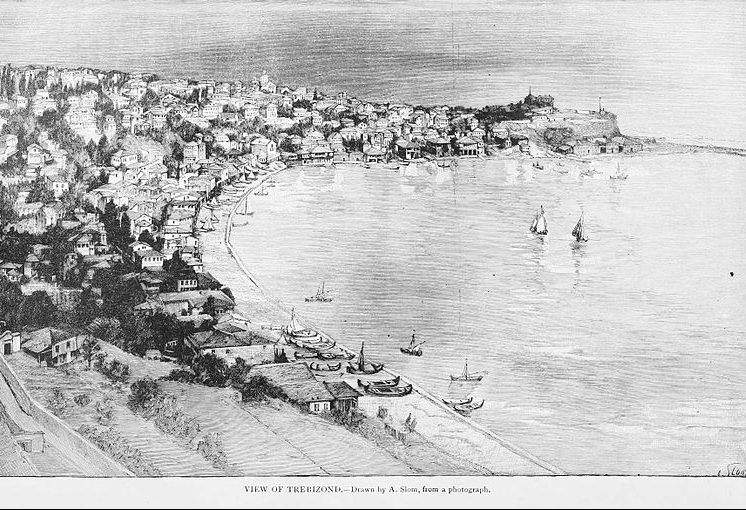
“A multiethnic seaside town inhabited by 20,000 Turks, 15,000 Greeks, and 7,000 Armenians, Trabzon in the 1890s was ripe for tensions. Turks in the area claimed they feared large-scale Armenian violence, though as one missionary put it, ‘it seems incredible that they could have been sincere in this.’
‘Rumors of massacres at Constantinople tended to aggravate matters,’ Longworth reported. There was considerable homegrown instability, too. On October 2, 1895, Lieutenant General Bahri Pasha, the outgoing vali of Van, was nearly assassinated in Trabzon, on his way to Constantinople. Bahri had been walking with the Trabzon town commandant, Ahmed Hamdi Pasha, when both were lightly wounded by a gunman. The shooter was not caught, but the Turks charged two ‘accomplices.’
The situation escalated further on the night of October 4, when ‘large bands of armed Muslims from the neighboring villages,’ intent on plunder, attacked Christian houses, firing guns and breaking in doors and windows. A rumor then spread that Christians were massacring Turks—or, alternatively, that Armenians had assassinated the vali. A mob of ‘at least 3,000’ mustered, ‘with knives, pistols and revolvers,’ and rushed through the streets. Christians fled to consulates and public buildings. But the vali, Kadri Bey, intervened along with his troops and some Muslim notables. They arrested the ring-leaders and ‘unmercifully beat’ many of the ‘rowdies.’ The crowd dispersed before any lives were lost. The next day, the local consuls—British, Russian, French, Belgian, Austrian, Greek, Persian, and Italian- ostentatiously rode in procession down the main street to government house. Their aim, Longworth explained, was to ‘calm the fears of the Christians and strike fear in the hearts of the Turks!’
The Turks were not impressed. On October 8, at about eleven o’clock in the morning, the mayhem in Trabzon began ‘like a clap of thunder in a clear sky.’ Turkish authorities later claimed that ‘it was impossible to determine on which side the brawl began’ and that Armenians ‘from their shops and bazaars . . . indeed from anywhere and everywhere . . . fired at random on soldiers, police, zapties, and citizens alike’ such that the ‘crowd which found itself in the square and the adjoining streets was obliged to respond.’ But Western observers—not to mention Armenian witnesses—knew just what they saw: the Turks had initiated the massacre without provocation. According to an unsigned report, probably by an American missionary, Armenians were shot down in the street ‘or sitting quietly at their shop doors. . . . Some were slashed with swords. The Turks ‘passed through the quarters . . . killing the men and large boys, generally permitting the women and younger children to live. For five hours this horrid work of human butchery went on’. (…)”
Excerpted from: Morris, Benny; Ze’evi, Dror: The Thirty-Year Genocide: Turkey’s Destruction of Its Christian Minorities, 1894-1924. Cambridge, MA; London: Harvard University Press, 2019, p. 73f.
In Trebizond, on 8 October 1895, “Armenian shops were looted, merchants killed on the spot. Homes, ransacked. In one day nearly a thousand Armenians lay dead in the ruin. But this was just the beginning. That same month massacres took place at Erzinjan [Erzincan], Erzurum, Gumushkhane [Gümüşhane], Baiburt, Urfa, and Bitlis.”[15]
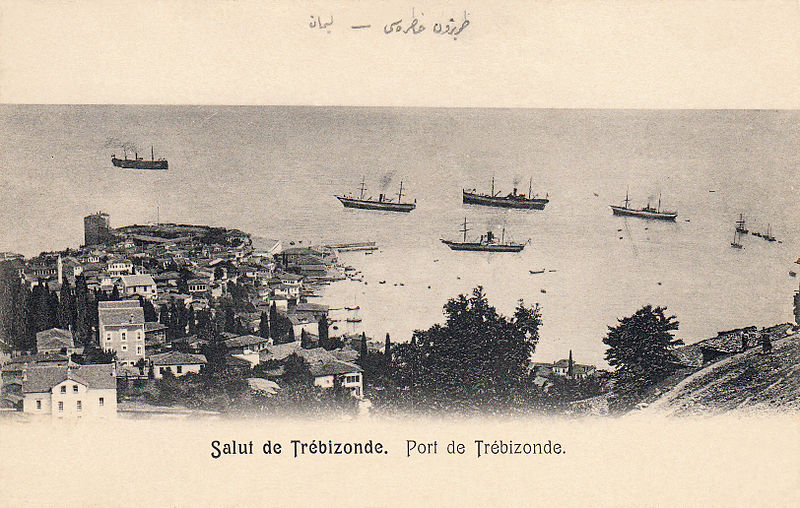
1914-1923: Repetitive Boycott, Discrimination, Persecution, Massacres, Deportations and Expulsions
The Christian population of the Trebizond province was repeatedly subjected to persecution, massacres, deportations and mass expulsions before, during and after the First World War. During the World War, the western part of the province was particularly affected.
According to a 1918 report by the Hellenic Foreign Ministry, a roughly estimated 200,000 Greek Orthodox Christians were deported within the Ottoman Empire during World War I.[16] Of these, 30,000 were ‘evacuated’ in February 1918 alone from the sancak Samsun, and 22,336 until January 1917 from the kaza of Giresun (Kerasus, Kerasounta).[17] These organized forced relocations are not to be confused with forced evictions, usually of entire villages that have been terrorized, plundered and burned down. Their inhabitants could only escape to the mountains and forests, where many of them died of exhaustion, hunger or diseases.
In late 1916, the Young Turks used the advance and encampment of the Russian army in the coastal region near the mouth of the Charsiotis (Karsit) River adjacent to Tripolis (Trk.: Tirebolu) and close to the inland town of Cheriana (Trk.: Şiran), as an opportunity to do away with the Greeks in the wealthy kazas of Tirebolu and Kerasus (Trk.: Giresun). Claiming that there was a possibility of collaboration between Christians and Russians, they decided to deport the Greeks on a military pretext. The first deportation, involving Greeks from the Tripolis area, took place between November 3 and 16, 1916.[18]“A postwar investigation by an American consul suggests that about 5,000 Greeks and a similar number of Armenians were eliminated from Samsun by massacre, expulsion, and flight to the hills. Samsun Turks also endured heavy losses during the war, in combat and from disease. There were also Greek deportations from the Fatsa, Nikassar [Trk.: Niksar], and Çarşamba areas. In all, in late 1916–early 1917, tens of thousands of Greeks were marched inland from the Pontus coastline along with a sprinkling of Armenians not deported in 1915. Speaking of Bafra-area villages in particular, Metropolitan Germanos told American officers that ‘the greatest cause’ of the deportations was ‘religion’.”[19]
“Greek witnesses alleged that Refet Pasha, the military governor of the Samsun district, burnt and depopulated dozens of villages between November 1916 and May 1917. During December 1916, the Turks deported notables from Samsun, Bafra, Ordu, Tirebolu, Amasya, and Çarşamba and apparently hanged 200 Greeks on charges of desertion. The villagers of the Bafra hinterland were sent ‘to wander from one village to another.’ An American naval officer noted that these deportees ‘were not massacred [like] . . . the Armenians’ had been. Instead, the ‘killing of the Greeks was accomplished’ through subterfuge. Pursuant to the deportation order, Greeks were ‘undressed and placed in Turkish baths for several hours, presumably to cleanse them so as to prevent any spread of disease. They were taken from these hot baths and [marched] . . . in the dead of winter, with very little clothing and generally without food.’ Naked and freezing, they died of ‘exposure, sickness or starvation.’”[20]
On 9 July 1921, the Hellenic Legation at Washington put the figure of Greeks, who “have been massacred, deported, or have died of famine since the war with Turkey began, according to a statement given out today by the Greek Legation” at 700,000. “Half of these victims are said to have been Greeks of Pontus and the others were from the interior of Asia Minor.”[21]
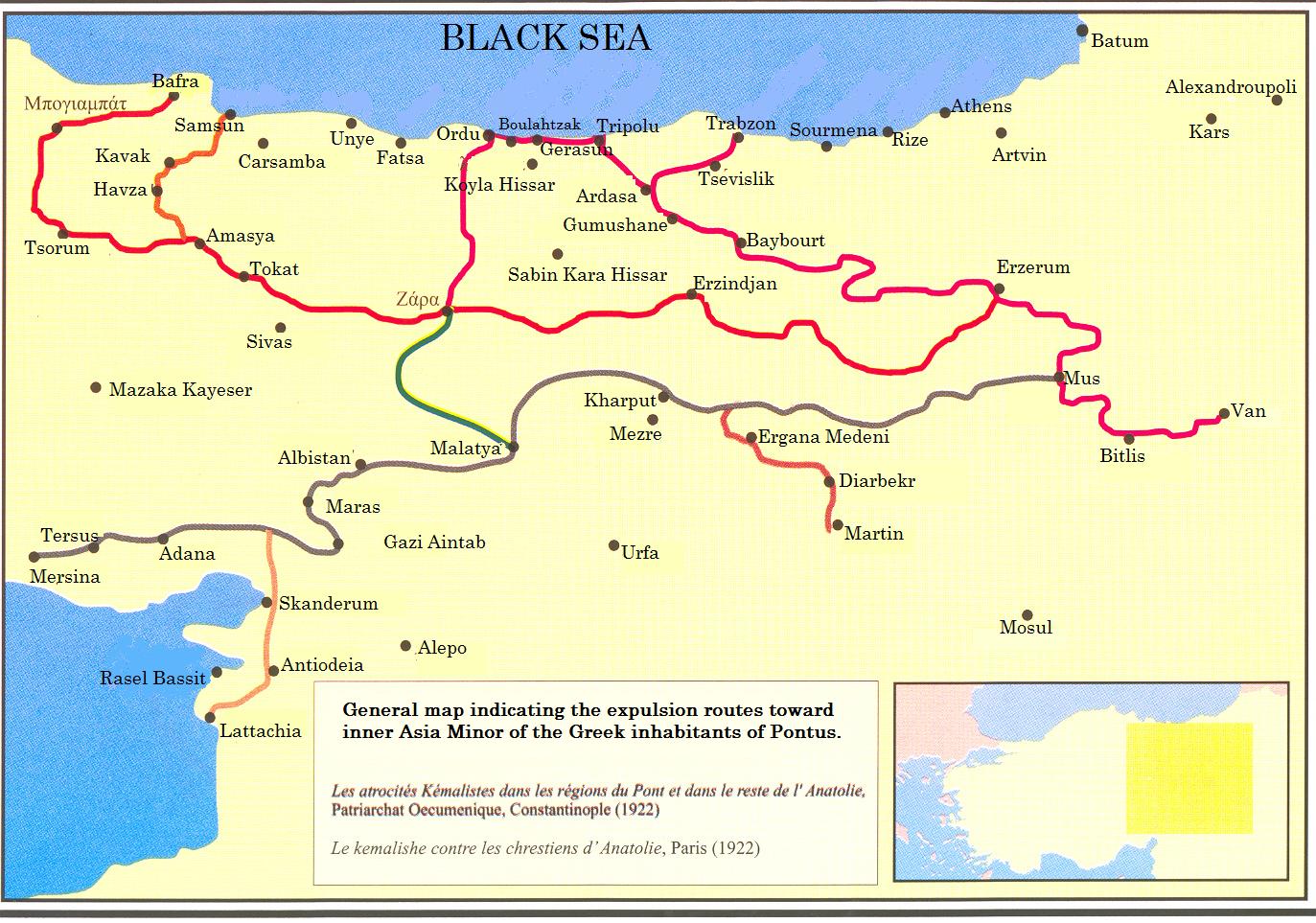
Anti-Christian Boycotts: Report by the German Consul in Trebizond (Dr. Heinrich Bergfeld) to the Chancellor of the German Empire (Bethmann Hollweg)
Trebizond, January 29, 1914.
The decision of the Turkish Greeks and Armenians not to participate in the parliamentary elections has caused an increased animosity against the Christian subjects of Turkey also in the Muslim circles of Trebizond and the neighbouring ports, which finds its expression in a boycott movement against them. The shops of the Christians are shunned by the Mohammedans and the steamships belonging to the Armenian Gümüchian are poorly served by the port staff than the other vessels.
The campaign undoubtedly originates from the “Union et Progrès” committee. The authorities are sympathetic to it. Even though they deny the existence of the boycott movement at all.
In general, there is no evidence of animosity against foreigners. Their interests are therefore suffering there, where they coincide with the sufferings of the Rayahs. For example, the Italian shipping company’s steamships, whose agent here is an Armenian, meet with passive resistance from the port staff during unloading because not enough lighters are made available to them.
On this occasion, the contrast between the lower class of the population and the better-off is once again evident in Trebizond. The port staff, the porters, coachmen, etc., who are mainly the members of the committee, are pleased that the government circles are again calling for their help. They know that occasionally, when their tariffs etc. are revised, their counter-calculations will be accepted. The better circles which are averse to the Committee feel that their interests have been violated, especially since the better shops, restaurants, etc. they prefer are in the hands of Armenians and Greeks. They point out that in the new appeal to the alleged patriotism of the lower classes of the population, their already intolerable arbitrary rule will only find new support and that the boycott movement will exacerbate the contrast between Mohammedans and Christians in an undesirable way. The consequences are already making themselves felt. They will remain, even if, as I would like to assume, the movement should soon subside.
The indigenous Christians are very worried, and rumours of imminent massacres are spreading through the city. In my obedient opinion, such fears are unfounded. The population of the local area seems to have a strong tendency to insubordination. But they will bend when faced with a strong will. The government will not lack it in the extreme. Because a degeneration of the movement could perhaps lead to Russian intervention. The ruling circles cannot close their eyes to this danger.
I have sent a copy of this report to the Imperial Embassy in Constantinople.
Bergfeld
Source: http://www.armenocide.net/armenocide/armgende.nsf/$$AllDocs/1914-01-29-DE-003
The Liquidation of the Armenians in the Trebizond Vilayet During the First World War
“In the years of the constitutional regime [i.e. since 1908], the Armenian political parties took an increasingly important part in the affairs of the Armenian community. During the legislative elections, the ARF [Armenian Revolutionary Federation; Arm.: Hay Heghapokhakan Dashnaktsutyun] also established close ties with the local Young Turks, who had a very narrow social base outside the circles of notables. (…) The Balkan Wars afforded the Trebizond Armenians an opportunity to show their attachment to the Ottoman fatherland by serving the army. (…)
However, with the agreement on the reforms in the Armenian provinces, a policy of harassing the Armenian population of Trebizond was initiated. It took various forms. Thus, the ‘patriotic’ fundraising drive that Trebizond’s Ittihadist club launched in February 1014, officially organized for the purpose of ‘purchasing warships’, was entrusted to local delinquents, who extracted large sums of money from the Armenians and the Greeks, sometimes going so far as to loot their stores. It also seems that, as had happened elsewhere, instructions were issued in the capital to boycott Greek and Armenian merchants in Trebizond.
When war broke out with Russia, Trebizond obviously constituted a strategic port of the first importance for the Ottomans; the Young Turk government planned to launch large-scale operations from the city. (…) even before hostilities commenced, the CUP [Committee for Union and Progress; Trk.: Ittihat ve Terakki Cemiyeti; alias Young Turks] sent some of its most eminent members here: Mayor Yusuf Rıza Bey, a member of the Ittihad’s Central Committee, who was put at the head of the Teşkilat-i Mahsusa [‘Special Organization’], and Yenibahçeli Nail, a renowed CUP-fedayi, who served as the party’s delegate in the vilayet.”[22]
As governor (vali), however, Cemal Azmi was the main political leader in the region; the Ecumenical Patriarchate of Constantinople characterized him as ‘grecophobic’ in 1919.[23] Appointed to his post on 7 July 1914, shortly before the general mobilization – he held his post until 2 February 1917 – Azmi played, among others, a significant role in the recruiting of irregulars (çeteler) by appealing to the bands of brigands who infested the vilayet’s mountainous regions, and obtaining an amnesty for them. On the question of how the Armenian population of the province was to be annihilated, Azmi – apparently out of consideration for the foreign representations (consulates) in the port city of Trebizond – spoke out in favour of an apparently legal procedure in which massacres too close to the city of Trebizond were to be avoided.[24]
Regarding the question how the Armenian population of the province was to be annihilated, Azmi – apparently in deference to the foreign representations (consulates) in the port city of Trebizond – spoke out in favour of a seemingly legal approach, which was to avoid massacres in too close proximity to the city of Trebizond.
Eliticide by Murdering and Drowning
As in other provinces, in Trebizond, an eliticide preceded the general deportation of Armenians. The young prelate Gevorg Durian (Turian), who had only been appointed in 1913, was summoned on 15 June 1915 by order of Azmi to be a witness at the court martial in Erzurum, and was murdered by the gendarmes accompanying him on the way between Erğana and Gümüşhane.
“On 24 June, 42 notables, including the Dashnak leaders, the city’s leading businessmen, and teachers, were summoned to the konak and informed that they were to be ‘immediately transferred to Samsun for an investigation already in progress’. Put aboard a boat the next morning, these men were killed on the black Sea opposite Platana [Akçaabat], 15 kilometres west of Trebizond, by çetes under the command of Tekkeli Neşad.”[25]
Regional Specifics of the Genocide against Armenians
The official deportation order of 26 June 1915 provided for a deadline of five days for implementation. “Here, however, we see a notable difference from other vilayets: there were no systematic arrests of the men before the deportation began. Apart from the political activists apprehended on 24 June, only 300 young men were arrested the day the deportation order was issued, put aboard a cargo ship that proceeded to cast anchor opposite Platana [Akçaabat]. The çetes charged with murdering these men and throwing them into the sea were then transported to the spot by motorboats.
Among the other arrangements made at Trebizond that are significantly different from those made elsewhere was the fact that the Armenian population was not authorized to sell its moveable assets or purchase any means of transportation before being deported.”[26]
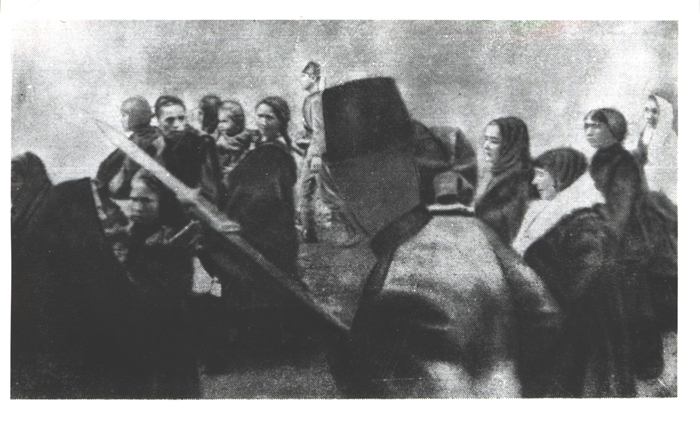
Deceit of Humanitarian Initiatives and Forcible Child Transfer
Also in contrast to the genocidal procedure in other provinces, “it was authorized – ‘whenever the parents so desire’ – to leave children – girls up to the age of 15 and boys up to the age of ten – in homes baptized ‘orphanages by the Turks’. The Greek metropolitan, Bishop Chrysanthos, who seems to have been well aware of the nature of the orders that [Dr. med. Bahaeddin] Şakir had issued, had interceded with the vali [Cemal Azmi] on the eve of the departure of the first convoy of deportees to convince him to spare the children and create an orphanage for them, claiming his prelacy and the Greek community were willing to take charge of the institution. A committee chaired by Cemal Azmi himself, with Chrysanthos as its vice-president, was formed in order to organize the functioning of the orphanage. But the local Ittihat Club and its leader, the CUP delegate Nail Bey, opposed this initiative and succeeded in having the orphanage closed. Its children were distributed among the Turkish ‘homes’. For their part, Dr. Crawford, the director of Trebizond’s American school, and his wife admitted several dozen Armenian children into their institution, and also accepted deposits in the form of money and jewels from the future deportees, in violation of the rules laid down by the authorities. The authorities thereupon successfully demanded that the children and the Armenian goods left on deposit be turned over to them. In other words, the humanitarian initiatives encouraged by the vali were rapidly transformed into an opportunity to buttress the program if ‘Turkification’ of children espoused by the Ittihadist Central Committee in Istanbul.
Informed by the massacres that had recently been committed in the neighbouring region of Erzurum, the Trebizond Armenians had no illusions about the fate that awaited them and gladly turned over their children when the Greek metropolitan and the American missionary offered them that alternative. The ostensible magnanimity of Cemal Azmi, which was highly praised by Bishop Chrysantos, was in the end only an artifice designed to get control of the children, whom Nail parcelled out among the ‘homes’ known as baş baba [‘main father’] and orta baba [‘half father’]. They were sometimes also placed in Turkish households as adoptive children or sexual objects, or else admitted to the Red Crescent’s hospital, where they were given ‘medical care’ or invited to make a last voyage to the Black Sea.” [27]
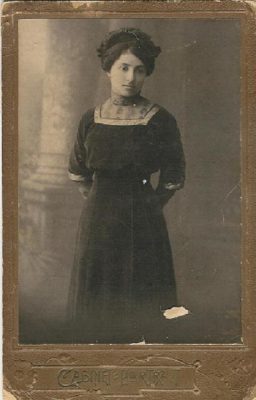
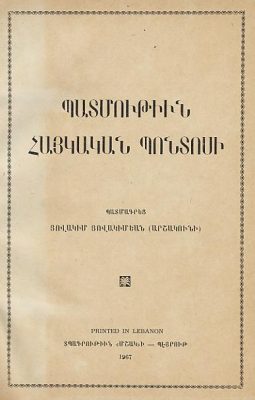
Theofanis Malkidis: Γενοκτονία έν Ροή – The Genocide against the Greeks of Pontos
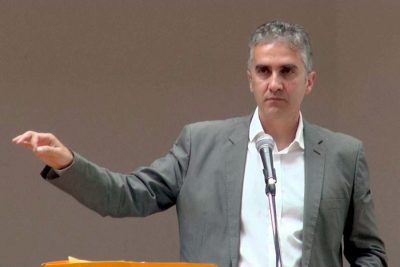
(…) The genocide of the Greeks of Pontos can be divided into three phases:
– The first phase commenced in 1908 and lasted until the beginning of World War I. During this period, the rise of the Young Turks, the Balkan Wars and Germany’s military alliance with the Ottoman state created the conditions for the beginning of the persecution of Christians.
– The second phase begins in 1915, when the conflicts of the First World War contribute to the spread of the policy of genocide. In 1918, the Austrian consul in Trebizond estimated the exiled or deported Greeks from Pontos at 80,000-100,000. In contrast, Greek testimonies speak of 233,000 dead and of 85,000 Greeks expelled to Russia.
– The period 1919-1924 is the last and most intensive phase of the genocide. During this period, Mustafa Kemal consolidated his position in the centre of the Ottoman state, a process that coincided with the formation of the Soviet Union and its support for the nationalist Kemalist movement. Furthermore, Greece’s military presence in Ionia and Eastern Thrace increased and the foreign policy of the major European powers changed. It is the time when the issue of the creation of an independent Pontic State is being raised, but it coincides with the rejection by Eleftherios Venizelos and with the unification of the forces of Mustafa Kemal and Topal Osman.
The decision for a mass destruction of the Pontos Greeks was already taken by the Young Turks in 1911. It was implemented during the World War and completed by Mustafa Kemal in 1919-1923. The persecutions initially unfolded in the form of acts of violence and expulsions. Very quickly, however, they took on a systematic and organized scale and were targeted at the Greek and Armenian communities.
The provision of weapons to Greeks by Russia was considered a pretext for the expulsion of the Greeks from Sinope to Alatsam. The coastal town of Kerasounda (Kerasunta; Giresun) was devastated. According to the reports of Metropolitan Germanos [Archbishop of Amassia and Samsoun, Germanos Karavangelis], there was a danger that another 100,000 Greeks in the coastal regions between Alatsam and Kerasounda would suffer the same fate.
In December 1916, Ministers Enver and Talaat, both leaders of the Young Turks, drew up a strategy for the genocide of unarmed Greeks from Pontos. The plan provided for the immediate extermination of the men between 16 and 60 years of age and the exile of all remaining men, women and children of the villages to the interior of Asia Minor, with the aim of destroying them. This strategy was pursued mainly in the regions of Samsun and Bafra. The Trebizond region was occupied by the Russian army in April 1916, so that no deportations or massacres took place there. However, when the Russian armed forces withdrew in February 1918 from the Ottoman Empire because of the revolution in Russia and the emergence of Soviet power, almost half of the Pontos Greek population gave up their homeland and followed the Russian army. Most of the refugees settled in the South Caucasus and the coastal regions of Georgia.
The appearance of Mustafa Kemal in May 1919 signaled a new wave of persecution against the Pontos Greeks, despite the Sultan’s orders to protect the Greeks and Armenians.
The “Daily Telegraph” criticized the persecution of the Greek population of Asia Minor in 1919 and wrote that the expulsions were without precedent in Turkish history. Nationalist, i.e. Kemalist gangs besieged Greek villages, killed their inhabitants and looted all buildings.
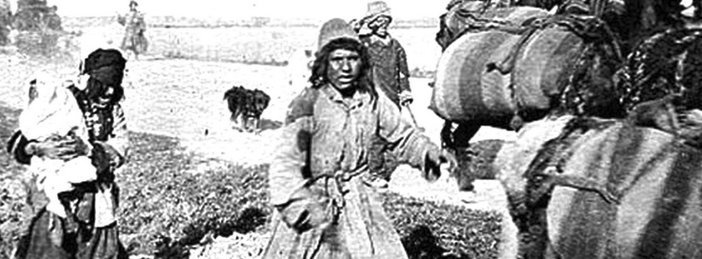
(…) Military, political and “institutional” means were used for the victory of Kemalism. Among the latter were the “independence courts” in Amasya. There, the Pontos Greek defendants were given a short trial: after a defense speech, the defendants were informed of the court’s decision, which consisted of execution by hanging. The political, religious and intellectual leadership of the Pontos found death in this eliticide.
These events have affected parliamentarians and the Senate in the USA as well as Turkish officials 1920-1921. The legal counsel of the Command Centre and the Chairman of the Istanbul Audit Commission reported that the Greeks of the Pontic coastal areas were the most important factor in the region because of their diligence and prosperity. Under Mustafa Kemal and with the participation of military and civil officials, the extermination of the Greek population of the Pontos took place from February to August 1921. 6,000 Pontos Greeks from the Bafra region were locked into the churches and burned there: elderly and adult men, women and children. Some of the women were taken inland by the irregulars (Trk.: çeteler; Grk: Tsetes[28]), raped and then murdered. Of the 25,000 Greeks in the Bafra region, 90% have been destroyed. The deportees were murdered in the interior of Turkey.
At the session of the Turkish National Assembly on May 8 and 21, 1922, Ismet Inönü admitted that the Greeks from Pontos were massacred at the government’s order: “Gentlemen, you have been informed that a committee of Americans has been formed at the request of Vekil Patriki Prousali to conduct interrogations on the massacre in Pontos. The slaughter of the Giaur (i.e. unbelievers; that is what the Turks called the Greeks) took place when the Hellenes rebelled, slaughtered many Turks, desecrated their harem ladies and appropriated their possessions. Only then did the central government give Topal Osman Agha the order to slaughter.” Hakki Chami Mpei, the deputy for Sinope stressed that “our faces will be stained forever because of these deportations. If these deportations are carried out with the intention of murdering people, then, gentlemen, this is a most heinous act. It stains us in the eyes of the whole world. Because the government will no longer be able to defend itself. I saw it with my own eyes. There have been atrocities committed.”
From the beginning of World War I to 1924, Young Turks and Kemalists destroyed thousands of Pontic Greeks in the manner outlined here. According to the Black Book of the Pontian Central Council, the victims of the mass murders up to 1922 were 303,238, followed by another 50,000 victims by spring of 1924. This means that by March 1924 a total of 353,000 Pontus Greeks had been annihilated, that is, more than half of the total Pontian Greek population, if we take the statistics of 1914, according to which there were 700,000 Greeks in the Pontos region.
The Young Turkish and Kemalist authorities prepared and participated in the genocide. The orders for the deportation of the Pontos Greek population to Kurdistan and Syria took the form of either governmental decisions or draft laws of the National Assembly, such as those of 12 and 16 June 1921, which bear the signatures of Mustafa Kemal and his ministers.
The terror, the forced labor battalions, the expulsions and executions, the burning down of villages, the rapes and murders have forced the Pontic Greeks to leave their homes and resist the extermination plan. Today it is clear that without the Pontos Greek rebels, this genocide would have claimed an even greater number of victims.
The genocide of the Pontos Greeks culminated in the uprooting of the survivors. Thus the last remnant of this cumulative, continued genocide – Γενοκτονία έν Ροή, as it was called – settled in Greece. Many Pontic Greeks had to go through difficult times there, so that soon a large number of the refugees and forcibly displaced persons were seeking better living conditions abroad. In less than a generation, many of them fled again at the end of the civil war.
There, in the states of the former Soviet Union, they will see their relatives again and learn about the fate of the missing.
This repeated uprooting of the Greeks from Pontos is an unprecedented crime in human history. After 27 centuries, the majority of a people is uprooted, leaving behind houses, churches, the burial places of their ancestors and fleeing to the coasts of Greece. Macedonia, Thrace, Athens, Thessaloniki, Piraeus, Patras, Volos, Kavala and Drama are the main areas where Pontos Greeks settled. Many of them found themselves after exhausting marches in the USSR, Iran, Syria and elsewhere (Europe, Australia, USA).
Source: Excerpted translation of an article by Theophanis Malkidis, “Η γενοκτονία των Ελλήνων του Πόντου. Ιστορικές, πολιτικές και διεθνείς διαστάσεις” (The genocide of the Greeks of Pontos: historical, political and international dimensions), http://neolaia.poe.org.gr/default.aspx?catid=186; German version: http://pontos-muenchen-ev.de/de/genoktonia/
Konstantinos Emm. Fotiadis: Deportation and Death Marches During the First World War
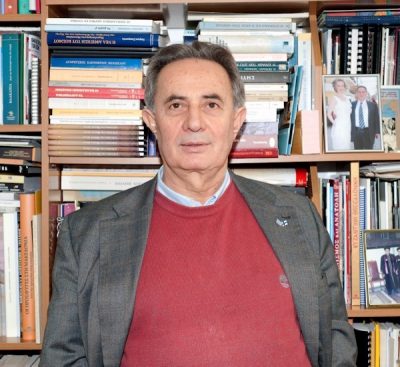
Under the pretext of preventive safety measures, the relocation of Greek populations from the coastal areas of Ionia and the Black Sea to the interior of Anatolia was initiated. As E. Allamani and K. Panagiotopoulou have stated, the Greeks were informed that this measure was designed to protect them from the enemy fleet; but the uniformity of execution proves that the measure was instigated in accordance with specific instructions from the Ottoman administration. The gendarmerie would land in the scheduled location, round up the inhabitants in the town square, and order them to prepare for immediate departure. The deportation usually took place in winter, under adverse weather conditions, and it was forbidden to the deportees to carry food, clothes or mattresses. As soon as the caravan started out for its unknown destination, the Greeks’ houses were occupied by Turks who had arrived from adjacent towns and were obviously impervious to the threat of the enemy fleet. The caravans would only stop at uninhabited locations, preventing the deportees from obtaining any supplies, while treatment of the sick and burial of the dead were prohibited. It was also obligatory for deportees to undergo ‘disinfestation’ in steam baths (hamamler), followed by exposure to the cold in order to be counted and medically examined. After the hamamler ‘clearance’, (…) the march would continue without food. Any donation of food, as well as the sheltering of abandoned infants, was forbidden to fellow Greeks on penalty of death. The resettlement locations were invariably isolated villages in the interior of Anatolia, inhabited exclusively by Turks. There, far from the Patriarchate and devoid of any spiritual guidance, most of the survivors were forced to accept Islamization.[29]
In April 1915, the inhabitants of Matsouka (Trk.: Maςka) were ordered to abandon their homes and were deported across the Pontic Alps to the interior of Asia Minor, most of them to the Erzurum plateau. The sufferings they underwent in the region’s chill April weather were indescribable. Starvation and infectious diseases would deal the final blow to the Greeks. The freezing cold was the main cause of death among deportees. Confidential decrees and orders rendered Christians outlaws and their life worthless. Yiorgos Laparidis, who survived the hardship of exile to Erzurum, describes in a tragic yet concise manner his personal strife, and that of his fellow villagers:
It was 1916. The Russians took Zavera and the Turks ordered that all the men of my village be deported to Erzurum. The weather was chill; it was the middle of January. It was so cold that stones would crack, but we poor men had to go on marching unshod and inadequately clothed. If someone had a pair of peasant shoes on, he was considered very lucky. While we were walking, the gendarmes would hit us with their rifle butts and push us into the river Kanis. We’d become sopping wet. Then they’d lead us out of the river and we would start walking again. Our wet clothes froze on us and the ice could be heard crackling as we moved on.
God alone knows how many people died on the way, or fell ill from the cold, or starved to death!
When my group was assembled in Zavera, there were 120 of us. Only 45 made it back…[30]
The main goal of the population relocations, plundering and burning of villages, rapes and murders was to alter the ethnic character of the Greek areas so as to facilitate the Turkification of the remaining inhabitants. The Hellenic government was given preliminary warning of this imminent danger in an official report to the Hellenic Ministry of Foreign Affairs dated January 14, 1915: “Among the resolutions of the Young Turk administration is the Turkification of the Greek populations, which is impossible to achieve due to the existence of purely Greek settlements. The needs of the military are the most suitable excuse for the dismemberment and Turkification of the Christian populations”.[31] According to F. Sartiaux
“The Young Turks ultimately revealed their grand plan to annihilate all native Christians in Asia Minor. Never before in history had the human mind been haunted by a plan more sinister than this.
Bloody slaughter was complemented by a system dubbed ‘white slaughter’, meaning gradual annihilation through abuse, displacement, the cold, prolonged lack of food and water, incarceration in cells so small that people could not stand on their feet. This terrible method perfectly suited both Enver’s fanaticism and brutality and Talaat’s cold and cynical imagination, because it enabled them to state that the relocations were being conducted on military grounds, and keep their hands blood free, since Christians would had simply died on the way![32]
At many places in the Ottoman Empire the trade with slaves re-emerged. For example, in July 1915, the Turkish police chief of Balıkhisar had the town crier announce that “Christian women could be put up for sale at the price of 5 lepta a piece”.[33]
According to the reports of the German ambassador to Constantinople, the arguments used by the Turks to justify the relocation of the Greeks who lived on the coast of the Black Sea were founded on false claims that the Russians had provided the Greek population with arms, thus subjecting the Turkish state to a possible Greek revolt[34]. This reasoning was faulty, since the relocated population consisted mainly of women, children and the aged.[35] Those fit to bear arms had either been drafted or had managed to escape to the mountains or abroad. Exaggerated by the CUP government, the guerrilla issue was also used as a pretext for imposing harsher measures on the unprotected women, children and elderly. At that time, even the German consul in Trebizond, Dr. Heinrich Bergfeld, considered information about the size of the guerrilla forces to be “downright exaggerations”.[36]
1919-1923: Violence against Christian Returnees; Expulsions, Deportations and Massacres
The Ottoman war capitulation of 30 October 1918 did not bring any easing of the situation, let alone security for the Christian population of the Pontos, which continued to be exposed to attacks by armed irregular gangs. Pontian Greek refugees, who had fled to Russian-controlled territory during the World War, had their return home hampered and even banned by the Ottoman ministry. On 9 July 1919, the Ottoman-Turkish newspaper Akşam (‘Evening’) thanked Ottoman Minister of Infrastructure Ahmet Ferit Bey for ordering that refugees were no longer allowed to stay in Pontos. Greeks of non-Ottoman nationality were denied the right to settle.
“By late January 1919, between 10,000 and 40,000 Greeks had returned to Samsun and Bafra, many living in makeshift ‘mud huts’ and in the street, as usurping Turks, ‘gypsies,’ and Albanians, ‘with the connivance of the authorities,’ refused to vacate their homes. The kaymakam of Bafra reportedly told returnees ‘to go and live with the Albanians and become their servants.’ A number of Bafra Greeks were killed trying to regain homes, even as some empty Armenian homes were being torn down and ‘sold for wood.’
Kapancızade Hamid Bey, the governor of Samsun, was set against any Greek revival in the city. He did not see Greeks as refugees trying to go home, but as enemies of the state: ‘It seemed as though the Samsun area was already in the hands of the Pontus rebels,’ he wrote in light of the ongoing repatriation. The situation in Kastamonu vilayet was little better. Returning Greeks were ‘in a very pitiful condition,’ though the Turkish authorities provided them with transport and ‘repatriation expenses.’ Greek children were ‘nearly naked, their scraps of clothing consisting of pieces of sacking, curtains, cushion covers and strips of mattress cloth’ In Merzifon and its environs, Greek refugees were returning ‘to wrecked homes and ruined villages.’ The returning refugees formed ‘bands’ to defend themselves and reclaim their property, giving the Turks a ‘pretext’ for violence.”[37]
The days of the Ottoman government in Constantinople were numbered. In numerous regions, so-called committees for the defence of national rights (Müdafaa-yi Hukuk Milliye Cemiyetler) called on the Muslim population to resist the victorious allied powers. Since the Muslim population in many places feared to suffer the same fate of expulsion and expropriation as the Ottoman Christians before them or through them, groups of irregulars soon formed, which were also joined by deserters from the Ottoman armed forces. In order to comply with the provisions of the Mudros Armistice Agreement, the Sultan therefore ordered the liquidation of the gangs and sent General Mustafa Kemal to Samsun with such an order on 19 May 1919. But he had made the goat a gardener. Kemal had been commander in the Special Organization and had belonged to those officers who had led the partisan fight against the Italian army under a false identity. He was therefore an expert in sabotage and partisan fighting. Instead of carrying out the orders of the Ottoman head of state, Kemal was at the head of the armed anti-allied movement. Not only did he give refuge to high-ranking colleagues of the notorious Special Organization in the territories under his control, but he also gave them important posts.
The consequences of the Kemalist-nationalist movement in Pontos, which was rapidly gaining in popularity and strength, are described in a report by British Lieutenant S. J. Perring from the Erbaa area dated 25 July 1919:
“This area is replete with robbers. This situation is encouraged by the local Turks, civilians and soldiers alike. There is an agreement whereby the local military authorities supply the Turkish bands with guns and provisions. Captain Izzet Bey, second in rank, visits the robbers’ villages continuously….
They continue to hold orphans and women and children who have become Muslim, despite the fact that there are orders to do otherwise. Since it is impossible to execute such orders while war rages, the Christian population is awaiting the right moment to leave en mass following the failure of the Allied landings. However, at the moment, it is not possible to do such a thing given the state of the roads.
I received urgent appeals to send military aid here. I request the compiling of a catalogue of culpable Turks, against whom the entire Christian population is prepared to give evidence. There is no doubt that such arrests and removals would be to the considerable benefit of the remaining populace, and might perhaps stop further blood being shed in the future.
The leader of a Greek resistance corps, who recently surrendered, was murdered in the local market, and there is no doubt it was carried out on the orders of the military authorities. The local administrator, who is a hard-working and intelligent man, is of no use whatsoever in this situation as he is an Armenian.
The Greek population today: 7,743. Pre-war: 18,000.
Many hundreds have been hanged. Those remaining died of hunger and disease. They informed us that their situation worsens by the day, that they are unable to cultivate their fields, that they dare not travel even a short distance after dark, and that they are threatened by the Turks all the time.” [38]
The situation in Thermi (sancak Samsun) was even worse. According, once again, to S.J. Perring, of the 835 Greeks and 75 Armenians who lived there until 1919, none remained. “I was informed by the only Greek I found that apart from very few in the villages, he was the only survivor he knew of. Of the 140 Armenians who were ejected, none returned. All the Greek property has been destroyed; I handed the few houses left standing over to the only remaining Greek, instructing him to rent them out and send the rent to Samsun. I ordered the administrator to gather the orphans and send them to Samsun, but I couldn’t get any figures and I fear that the result will not be satisfactory”.[39]
The British Admiral of the Fleet Sir John Michael de Robeck, who served as Allied High Commissioner in Constantinople in 1919-1920, reported on 24 November 1919: “The situation in the vilayet of Trebizond is one of progressive deterioration. The area of Kerasus, for instance, is openly controlled by the leader of the looters, who dictates to the local authorities. The Vali of Trebizond is powerless or too weak to impose himself on the bandits.”[40]
In the following years 1920 and 1921 the number of massacres increased even more.
„Terrible massacres are reported from the seaports of Samsun and Trebizond the capital of Armenia. The streets are strewn with bodies of Greeks. Many shops have been ransacked. An American destroyer has arrived at Samsun to protect American subjects there.”[41]
In June 1922, the Royal Hellenic Legation to Washington reported, among other incidents in the adjacent Sivas province, a massacre at Platana [today Akçaabat], where “all the best Greek houses were set on fire and the inhabitants massacred.”[42]
Eliticide on Pontic Greeks
The Kemalists adopted the genocidal methods of the Young Turks, including deportations and eliticide, i.e. the targeted arrest, condemnation and execution of political, intellectual and spiritual Christian elites.
In all areas under control of the Nationalist government hundreds of Greeks were executed by hanging – or massacred, in particular during the initial phase – among them many publishers, entrepreneurs, the mayors of towns and villages and previous members of the Ottoman parliament. Thus, the intellectual and political elite of the Asian Minor Greeks was destroyed in the course of a few months. In June 1921 seven Orthodox priests from Alaçam, Bafra “and outlying districts were arrested and after being publicly tortured, were crucified in the market-place of Guioz-Keuy [Göz-Köy].”[43] In the Pontos region alone the daily rate of hanging was 60 during September 1921. In one day, on 22 January 1921, Kemalist military courts (‘Independence Courts’) sentenced 72 prominent Greeks – including scientists, educators, officials and business figures – from the cities of Samsun, Alaçam, Bafra (Grk: Pafra) and other towns to death by hanging for alleged rebellion. [44]
In his telegram to the League of Nations the Ecumenical Patriarch of Constantinople quoted the Turkish newspapers of Samsun, the Ehale and the Helal of 18, 19 and 25 September 1921, giving a list of three Armenians and 168 Greeks, including two naturalised Americans, one missionary and the other Professor at the American College at Merzivan [Armenian: Marzovan; Turkish: Merzifon; also Merzifun], who were condemned to death and executed.[45] In the vicinity of Kavak (Pontos), 1,300 Greeks were shot on 15 or 16 August 1921 in about two and a half hours.[46] During the meeting of the Armenian-Greek-Section (A.G.S.) of 31 August 1921, Dr. Théotokas read the Ecumenical’s Patriarchate’s report of 24 August 1921, which also covered the “question of Ottoman Greeks who were being tried by the Turkish Courts for supposed acts of brigandage; and said that the prisoners were being ill-treated and subjected to severe humiliation, and that, through fear of worse treatment, they made no complaint to Captain Wilson, when he interrogated them on the round of inspection.”[47] In the A.G.S. meeting of 12 October 1921
“(…) Dr. Théotokas said, that a Greek lady who had escaped from Samsoun [Samsun] had furnished the Patriarchate with a reliable and vivid account of the recent executions in that town. The victims were given three days notice of their fate; they were hanged naked and in batches, all the condemned having to undergo the terrible ordeal of standing by and witnessing the executions until their turn arrived. In one case a father and son were given the option of choosing which should be hanged first.”[48)
A fortnight later, the representative of the Ecumenical Patriarchate added information on massive executions by hanging in Amasya. The A.G.S. minutes of 26 October 1921 concluded:
“These additional details show with what deliberation and studied cruelty, these sentences have been carried out; the victims were alleged to have been hanged in batches, the first victim being the aged Abbé Platon, Metropolitan Vicar of Samsoun [Samsun]. After these executions, the bodies of the victims were stripped of their clothes and valuables, and the gold teeth of the executed extracted by the Turks.”[49]
The Pontian Greeks were particularly endangered in the interior of the country, where the absence of foreign representations made it easier for the Kemalist gangs (‘liberation units’) to carry out their work of annihilation undisturbed and with impunity.
The reduction of foreign presence was also served by the decree of the Kemalist government in Ankara of 5 January 1921, according to which Christian educational institutions – with the exception of American ones – had to close. [50]
Konstantinos Emm. Fotiadis: Discrimination and Destruction of Greek Physicians
In early 1920, the Allied High Commissioner of Greece, Efthymios Kanellopoulos, reported: “In pursuit of their goal to exterminate Christian ethnic groups, the Turks did not fail to discern that a blow against Christian scientists was important for their full success. Therefore, they also deviously persecuted Greek doctors, at a time when they were treating the sick—and Turkish soldiers, in particular—regardless of race or religion, in accordance with the principles of their humanistic profession.”[51] The process began with a secret and strict order by which Turkish families were forbidden to consult Christian doctors. Compliance was so universal that even those responsible for its implementation were impressed by the results.
The drafting of physicians in times of war is indisputably a common practice everywhere in the world. In this case, however, it was the first time since the establishment of the Ottoman Empire that Christian doctors were obliged to join the Ottoman army. What is clear, however, is that the inclusion of Christian doctors as well as the remaining Greeks in the mobilization was not intended as a defence measure; its underlying rationale was the annihilation of Christian ethnic groups, as the Association of Greek doctors concluded in its memorandum: “All of us felt this to be the case from the very beginning. It was the sad fate of many of us to die far from our family to no purpose and serving no ideal, lacking moral support and facing indifference, deprivation, misery and abandonment”.[52]
The departure of Greek doctors decreased the professional competition in favor of the Muslims. This was a significant advantage not only for the private but for the public interests of the Turkish state. Exposed to all kinds of sufferings with their health often too frail for them to cope, condemned to undergo hardship too harsh for their age, the potential victims of the epidemics they had to fight, Greek doctors were obliged to face all sorts of difficulties that their executioners intended to result in their deaths.[53]
After the armistice of Mudros in October 1918, some surviving Greek doctors wrote about their personal strife, the madness they had lived through, and mainly about the crimes of genocide they had witnessed. Some exemplary excerpts from this extensive body of writing follow:
After I had been drafted, I caught typhus and left myself to my fate, without treatment or attention, thinking that I was doomed to die. Nevertheless, fate decided differently and I managed to escape death, while every day a hundred people died around me. A fortnight after my fever ceased, I was ordered to assume my duties again; when I complained that I was still too weak to stand, they retorted: ‘You have to work till you’re dead. Your weakness is of no concern to us!’ You have to try and imagine the effort I had to make to walk and accomplish some of what was expected of me. For my support, I had to endure daily abuse and endless threats that it was us, the Greek subjects of the Ottoman Empire, who had created Greece’s navy, and that the Turks were waiting for Greece to enter the war so that they would get rid of us as they had done with the Armenians. However, they hastened to add: “With you, we are not going to make the same mistakes we did with the Armenians. You have to be slaughtered to the last man!”[54]
(…)
In Kurdistan I saw heaps of braids and women’s hair, pulled off the heads of unfortunate victims by those who dragged them to rape and slaughter; during their struggle, their braids were left in the hands of their executioners…
On the way from Erzincan to Erzurum in early May 1915, close to the road to Kara Su (Euphrates) and near Sansa I came across the bodies of five Greek soldiers who had been savagely murdered and slaughtered on the mountains because they dared offer some bread to the unfortunate Armenians who were being taken from one area to the other. I choose to mention only the bodies of the murdered soldiers and not the hundreds of bodies scattered on the ground along the path that I had been following for days. Those were soldiers from the labor battalions who had died of typhus and were left exposed, to be eaten by wild animals and vultures.
I have to stress that Sansa is the tomb of Greek soldiers [of Ottoman nationality] who had served in the labor battalions of Samsun, Kerasus, Trebizond, and Erzurum, and died or were slaughtered by the Turks during the retreat.”[55]
Excerpted from: Konstantinos Emm. Fotiadis: The Genocide of the Pontian Greeks; 2019; Chapter Four, paragraph 16: The Work Battalions
Forced Labor
On 21 July /2 August (new style), 1914, the Ottoman government declared a general mobilization, calling all men from 18 to 45 to arms (including Non-Muslim men who were drafted already in the age of 16 up to 55 years of age). Those who failed to present themselves within 11 days were to be considered deserters and sentenced to death.[56] The order was posted in all mosques, churches, coffee houses, and public buildings. All those on the black lists of deserters were executed.
On 23 July 1914 the Russian consul at Trebizond informed his embassy in Constantinople: “General mobilization continues in the district under my consular supervision. Orders that conflict with previous orders arrive daily. Every man had to bring enough bread to feed him for five days. The city is full of people without lodgings; several of them had to spend the night in the streets. According to the information at my disposal, apart from the Trebizond draftees, thousands of untrained recruits from other ports of Asia Minor have been sent inland. Several city doctors have been ordered to join the army as military medical staff and to travel to the camps by their own means”.[57]
As the C.U.P. (‘Young Turkish’) government distrusted the loyalty of non-Muslims, most of them were put into units that were used for road construction and load-bearing. These notorious forced laborer units (Trk.: amele taburları), popularly called ‘donkey units’ (eşek taburları), developed into a special method of extermination with particularly high death rates. These labor brigades “were nothing more than places of execution for the Christians taking place under the cruelest conditions imaginable. There was neither food nor clothing. There was no heating and there was the burning sun of the day and the extreme cold of the nights. In the depths of winter they lived in holes and caves.”[58]
A written order which was sent from the chief of public works, Ömer, to the supervisor of the Argana Maden labor battalions, Lütfi Bey, also reveals genocidal intent:
“To Lütfi Effendi, chief foreman in Argana,
We have been informed that our nation’s traitors, the Greeks, are not being taken to work if it is raining. This entails a daily burden of 860 grams of wheat at the expense of the state; furthermore, it hinders the attainment of our goal. Therefore, from now on and following your communication with the commander of the work battalions, we instruct you to send them to work in both rain and snow. No exceptions are permitted.
(Signed by) Ömer, chief of public works
Addressed to chief foreman Lüfti of the labor battalions.”[59]
Many Greek draftees did not survive the hardships of compulsory labour, malnutrition and poor accommodation or the lack of it altogether. In a German cable of 12 May 1918 to the Foreign Office in Berlin, the statements of Ottoman prisoners of war were repeated, who spoke of a ‘methodical annihilation of the Greeks’, due to the general mobilisation, the confiscation of property and the deportations. These captives mentioned a number of more than 200,000 Greek draftees until the end of 1917, of which many had been slaughtered or committed suicide in order to escape the hardships, ill-treatment, diseases, starvation and cold weather.
The issue of the Ottoman Christian labour conscripts was raised during a parliamentary debate by Emmanouil Emmanoulidis (Εμμανουήλ Εμμανουηλίδης, 1867-1943), member of the Ottoman Parliament from Pontos, who on 4 November 1918 set before his colleagues in that body eight issues, of which the seventh had to do with the labour battalions:
“On the occasion of the conscription there were created the labour battalions. They [state authorities] destroyed through starvation and through general deprivations 250,000 from the men thus… We ask: ‘What does the new government know of the perpetrators? What does it think on this matter? And, when will it initiate the measures that it is able to undertake?”[60]
Conscriptions of non-Muslims, especially Greek Orthodox Christians, occurred before and after the First World War. Already on 2 March 1921, the National Assembly at Ankara ordered the reintroduction of labour battalions for Ottoman non-Muslims. According to Leyla Neyzi of the Sabancı University, “one of the main reasons for the formation of these units was to ensure that local non-Muslims (…particularly local Greeks) would leave their regions of origin and not join the forces fighting the Turks”.[61] Interestingly, the subscription into the labour battalions was also imposed on oppositional or otherwise ‘unreliable’ Muslims, according to the Armenian survivor Varteres Mikael Garougian. Being meanwhile sentenced to compulsory labour himself, he joined a labour unit that “was composed of mostly young Greek men, gathered after the massacres from the area of Samsun and now driven to this location [of Zara].“[62]
Expulsions and Deportations
The sancak and the city of Samsun (Grk.: Amisos) in the west of the province Trebizond remained particularly affected; they had already borne the main burden of massacres and deportations during the First World War, because they were outside the Russian occupied territory. The altogether nine deportations from Samsun – towards Malatya – began in June 1921; the last trek left Samsun on 13 September 1921. The New York Times already reported on 9 July 1921: “The notorious murderous chief, Osman Agha, arrived at Samsun the second day of Bairam, a Turkish holiday similar to Easter, inaugurating his entry by the murder of ten Greeks. Then, surrounding the stores of the American Tobacco Company, he arrested all the Greek clerks, numbering about 800, and had them transported to an unknown destination. The Greek quarter was then surrounded and 1,500 other Greeks arrested and deported to the interior.”[63]
“On June 21, 1921, the Kemalists decided to deport the Greek population of Kotyora [Trk.: Ordu]. Approximately eight hundred men and children, with a heavy escort of gendarmes, were taken to Meşudiye (Ordu district) without casualties, via the mule path from Kapatiz to Han Yeri and Chambashin. Ioakeim Saltsis wrote: ‘In Meşudiye we remained in strict isolation for two days. This measure was taken by the kind commander of Şebinkarahisar to protect us from falling into the hands of Topal Osman and to gain time, until that brute and his ferocious band had moved away from the Commander’s territory.’”[64]
Kemalist destruction of the majority of Greek villages in the kazas Samsun and Bafra was reported on 18 October 1921: “According to reliable foreign testimony, 420 out of 720 prosperous Greek villages in the Black Sea district of Samsun and Bafra, have been completely destroyed in the past few months. The male inhabitants were either massacred or deported, and the women were removed to the interior. The remaining 300 villages, it is stated, were partially destroyed, and are inhabited by only a few women. The principal organizer of this persecution was a boatman named Osman Agha, of Constantinople, now a Kemalist (Turkish Nationalist) colonel.”[65]
In early 1922, the deportations extended to the city and kaza of Trebizond.[66] “Most Trabzon Christians were deported inland. But some—from the village of Ardache [Grk: Ardasa, kaza Torul, sancak Gümüşhane], for example—were pushed toward newly occupied Russian areas. (…) Deportations from Trabzon to the Anatolian interior often resulted in rape and death. (…) The Turks maintained the pretext of military justification even when they were winning. When the tide of battle changed, and they reconquered Trabzon vilayet, they continued expelling Greeks systematically.”[67]
On 1 November 1922, the Turkish National Assembly at Ankara issued its decision to expel all the remaining Christian population from Asia Minor, estimated by the Near East Relief to be still about half a million of people.[68] The systematic mass expulsions, combined with boycotts, massacres and deportations in the Pontic area increased towards the end of 1922. „Ankara was eager to rid Anatolia of its Christians before the Lausanne Conference ended. By December 1922, a month into the conference, the evacuation was in full swing. [The head of the Near East Relief in Turkey, Harold] Jaquith described what he saw: ‘Death is overtaking thousands of the children and the aged infirm on the frozen roads of Anatolia. . . . Moving over the worst mud roads in the world, I saw a crowd of broken civilians more depressing than an army in hard-pressed retreat. Women about to become mothers tramped in snow up to their knees. Tired children dropped weary by the wayside, and girls of tender years bore men’s burdens.’ At the ports the waiting refugees suffered intimidation, robbery, and violence.”[69]
“The French high commissioner, General Maurice Pellé, said he had heard that ‘in all parts of Anatolia from Mersina to Trebizond’ Christian men aged eighteen to fortyfive were to be ‘made prisoners,’ and the rest were to be ‘expelled from the country’. (…) Along the Black Sea coast, the Christians were bluntly told that they had thirty days to leave, otherwise they would be marched to the interior. All knew what that meant. The order encompassed the Christians working in missionary institutions and the many thousands of orphans in their care. [The British High Commissioner at Constantinople, Horace] Rumbold, probably exaggerating the number of Christians left to expel, thought the order would affect ‘over one million Christians in Eastern Anatolia.’ Throughout Anatolia, the orders received the approval and reinforcement of the Muslim public. Newspapers lambasted the Christians, and neighbors threatened them with massacre. In November 1922 [the American consul at Aleppo until May 1923, Jesse B.] Jackson cataloged a litany of persecutions, big and small. Christians, he said, were excessively taxed, ‘beaten, robbed and [left] with no redress. A persistent boycott exists against them, preventing them from selling anything . . . at any price; also, whatever they are obliged to purchase from a Moslem they are forced to pay from ten to twenty times the value thereof.’ In short, ‘there is a clear understanding among the Turkish authorities and the Mohammedan population that everything possible is to be done to oblige the Christians to leave.’”[70]
In December 1922, Greeks from the Black Sea area including Trabzon, began to arrive in Constantinople/Istanbul and were placed into refugee camps on route to Greece. In January (winter) 1923 most of the Orthodox Christian families who still lived in Trebizond were told they must leave their homes permanently and gather near the harbour bringing only what they could carry. Within a few days, the uprooted Greeks were taken to disease-ridden refugee camps in Istanbul (where many died), on to Greece, their notional homeland. Many also died who had to walk long distances from their villages to the ports.
In the end, the only real choice for Christian Pontic Greeks was to leave their homeland or convert to Islam and remain in Anatolia.(71)
Greeks, whose ancestors came from the Pontos region, summed up their experiences of persecution and suffering under the terms spaghi (σφαγή – massacre) and xerisomos (uprooting; eradication).
